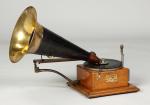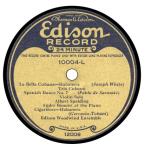EQカーブの歴史、ディスク録音の歴史を学ぶ本シリーズ。前回 Pt.10 では、1949年改定NAB規格の策定の経緯について調べました。その 1949 NAB 規格策定に至る会合では、高域歪を軽減するためにNAB標準規格(録音カーブ)のプリエンファシス(高域増幅)を弱めるべきだ、という技術的な議論も多くみられました。
On the previous part 10, I studied on the history and the background toward the revised NAB Standards in 1949. During the formulation, there was a strong discussion on the NAB Standards’ high frequency pre-emphasis, that was “too much” and “should be weakened to cope with the high frequency distortion”.
具体的には、100μs(+16dB at 10,000Hz)ではなく、少なくとも 75μs(約+13.5dB at 10,000Hz)に落とすべき、といった意見でした。
More precisely, many engineers and researchers at the time claimed that the 100μs pre-emphasis (+16dB at 10,000Hz) should be lowered at least to 75μs (approx. +13.5dB at 10,000Hz).
諸事情で少し間があいてしまいましたが、今回の Pt.11 はその続きで、1948年6月 に Columbia/CBS から突如発表された、家庭市場向け長時間レコード LP (Long Playing Microgroove) のエピソードです。長編になってしまったので、Columbia 録音再生 EQ カーブの話は次回 Pt.12 に回します。
A few months have passed since I posted the last article for some reason – anyway, this time as Pt.11, I am going to continue learning the history of disc recording – the introduction of Columbia/CBS’s LP (Long Playing Microgroove records) for consumer market in June 1948 and its history. As this Pt.11 became extremely lengthy, the story of “Columbia” EQ curves for recording/reproducing will be featured in the coming episode (Pt.12).
調べれば調べるほど、この LP というものが登場したいきさつや歴史自体が、推理小説のような面白さに満ち溢れたトピックでした。
The more I dug into the history (and advent) of Long Playing Microgroove records, the more excitements I got – like I was reading detective novels.

source: LIFE Magazine, July 26, 1948, p.40
MICROSCOPIC VIEW of the record surfaces shows contrast between the old-style .01-inch grooves in bottom half of picture and new .003-inch microgrooves shown above them. LP grooves diminish surface noise.
LIFE誌1948年7月26日号に掲載されたLP登場の記事より。マイクログルーヴLP盤の溝と、従来の78回転盤の溝を比較した写真
- 「Pt.0 (はじめに)」
- 「Pt.1 (定速度と定振幅、電気録音黎明期)」
- 「Pt.2 (世界初の電気録音、Brunswick Light-ray、ラジオ業界の脅威)」
- 「Pt.3 (Blumlein システム、当時のRCAやColumbia、民生用における高域プリファレンスの萌芽)」
- 「Pt.4 (Vitaphone、Program Transcription、Electrical Transcription、Bell Labs / Western Electric 縦振動トランスクリプション盤)」
- 「Pt.5 (ベル研とストコフスキーのエピソード、横振動トランスクリプション、Orthacousticカーブ)」
- 「Pt.6 (アセテート録音機のカッターヘッド特性、高調波歪の論文、超軽量ピックアップ)」
- 「Pt.7 (圧電ピックアップとジュークボックス、定速度記録再生の試み)」
- 「Pt.8 (1942年 NAB 標準規格策定の歴史)」
- 「Pt.9 (大戦中〜戦後、LP登場前夜の状況について)」
- 「Pt.10 (1949年 NAB 標準規格策定の歴史)」
の続きです。
This article is a sequel to
- “Things I learned on Phono EQ curves, Pt.0 (Intro)”,
- “Pt.1 (constant velocity/amplitude, early years of electrical disc recording)”,
- “Pt.2 (earliest electrical recordings, Brunswick Light-ray, Radio industry)”,
- “Pt.3 (Blumlein system, RCA and Columbia in the early 1930s, germination of treble pre-emphasis)”,
- “Pt.4 (Vitaphone, Program Transcription, Electrical Transcriptions, Bell/WE Vertical Transcription)”,
- “Pt.5 (Bell Labs = Stokowski episode, Lateral Transcription and Orthacoustic)”,
- “Pt.6 (Instantaneous Recorders, papers on distortion and lightweight pickup)”,
- “Pt.7 (piezo-electric pickups, jukebox, constant-amplitude recording)”,
- “Pt.8 (history of 1942 NAB Standards)”,
- “Pt.9 (various situations in the 1940s)”,
- and “Pt.10 (history of 1949 NAB Standards)”.
毎回書いている通り、筆者自身の学習過程を記したものですので、間違いの指摘や異論は遠慮なくお寄せください。
As I noted in every part of my article, this is a series of the footsteps of my own learning process, so please let me know if you find any mistakes on my article(s) / if you have different opinions.
今回も相当長い文章になってしまいましたので、さきに要約を掲載します。同じ内容は最後の まとめ にも掲載しています。
Again, this article become very lengthy – so here is the summary of this article (the same contents are avilable also in the the summary subsection).
1948年6月18日、ニューヨークのウォルドルフ・アストリアホテルで、Columbia LP がプレス向けに華々しくお披露目された。この時、101枚のLPアルバムと、同内容の78回転アルバム101セットが比較展示され、収納スペース効率化が喧伝された。また、LPの再生も披露され、従来のシェラック盤に比べてスクラッチノイズが非常に少なく高品質な再生音は、参加者を驚かせた。
The press demonstration of Columbia Long Playing Microgroove Records was taken place at the Wardolf-Astoria Hotel, NYC on June 18, 1948. 101 LP albums and a pile of 101 (78-rpm) albums were graphically demonstrated to prove less storage space needed for LP albums. Also listening quality demonstration was conducted, showing far less scratch noise, with better fidelity – that amazed participants.
マイクログルーヴLP開発は、実は1930年代のRCA Victor時代に端を発していた。その後、1939年にCBS傘下となったColumbia、およびCBSに、RCA/NBCのエンジニアが続々と集結、1939年から秘密裏に開発が進められた。
The development of microgroove LP records (surprisingly) originated from the experiments in the 1930s, at RCA Victor. After Columbia became a subsidiary of CBS in 1939, RCA/NBC engineers gradually joined Columbia, and started the top-secret project, behind closed doors.
RCA Victorから移籍しColumbia社長となったWallerstein氏は、1939年1月の開発開始にあたり、将来長時間レコードが実現した時のために、すべての78回転用録音を、16インチ33 1/3回転のラッカーにも同時カッティングしておくことを命じた。これにより、1948年のLP登場以降、旧譜再発に際して他レーベルよりも比較的高音質でのリイシューが可能になった。
Mr. Wallerstein, who left RCA Victor and became the president of Columbia, made a decision to make use of 16-inch 33 1/3 rpm lacquer discs for safeties on everything being recorded for 78rpm releases, so that the recordings would be immediately transferred to microgroove when the time was right. Because of his foresight, Columbia could reissue high quality LP reissues of pre-LP recordings, enjoying a big advantage to other labels.
第二次大戦中はプロジェクトは中断していたが、CBSでカラーテレビ開発に従事していた Peter Goldmark 氏が長時間レコード開発に興味を持ち、CBS/Columbia合同プロジェクトとして戦後直後の1945年に再スタートを切った。彼はプロジェクトリーダであったが、実質的な技術開発は、名うてのエンジニアたちによって行われたと考えられる。
The project was suspended during the WWII. Peter Goldmark, who was a CBS researcher, developing a color TV system, got interested in long-playing records as well, and the project resumed in 1945, as a CBS Labs / Columbia Records joint project. Although Mr. Goldmark was a supervisor of the project, it is said that most of the practical work had been done by a number of talented engineers from Columbia and CBS.
1948年4月、LPお披露目の2ヶ月前、CBS/Columbia は極秘に RCA/Victor に LP のデモを行い、技術ライセンス供与を打診した。しかしLPを構成する技術は特許になっておらず、またRCAとCBSの宿命のライバル関係もあり、RCAはそれを断った。翌年、RCA Victor は45回転7インチレコードを独自に発表、回転数競争が勃発した。
In April 1948, two months before Columbia unvailed LP records, CBS/Columbia held a meeting behind closed doors with RCA/Victor to demonstrate the newly developed record, and offered a license agreement. However, every aspect of LP technology was not protected by patents, and because there had been a long-time rivalry between parent companies (RCA vs CBS), RCA/Victor did not accept the offer. Next year, RCA Victor unveiled 45rpm 7-inch records – then started the famous “Battle of the Speed”.
Contents / 目次
- 11.1 June 18, 1948: The Day CBS/Columbia Unveiled Long Playing Microgroove Records
- 11.2 Who Contributed the LP Development? / LP開発の立役者は誰か?
- 11.2.1: 1933, When RCA’s “Program Transcription” Was Taken Off The Market
- 11.2.2: 1935, When Fred Barton tried to cut 1-mil records
- 11.2.3: 1939, When Mr. Wallerstein moved to Columbia as its new president
- 11.2.4: CBS (Columbia) and NBC (RCA Victor) in longtime egoistic competition
- 11.2.5: 1939〜, Wallerstein hires Hammond, Hunter, Liebler, Savory, Rodman (and Bachman in 1946)
- 11.2.6: 1936, Goldmark Joins CBS, to develop color Television system
- 11.2.7: 1945, Goldmark listens to 78rpm albums of Brahms’ Second Piano Concerto at his friend’s house
- 11.2.8: 1945-1948, CBS/Columbia’s collaborative LP development
- 11.2.9: Who Contributed in Which Aspect Anyway
- 11.2.10: Why Mr. Paley Gave All The Credit to Mr. Goldmark and the CBS Labs
- 11.2.11: “Battle of the Speeds” Could Have Been Avoided?
- 11.3 The summary of what I got this time / 自分なりのまとめ
11.1 June 18, 1948: The Day CBS/Columbia Unveiled Long Playing Microgroove Records
Columbia と CBS によって、プレス向けに33 1/3回転マイクログルーヴの LP が大々的に披露されたのは、1948年6月18日(金)、ニューヨークの ウォルドルフ・アストリア ホテル (Waldorf Astoria Hotel) においてでした。
It was at New York’s Waldorf Astoria Hotel on Friday, June 18, 1948, where Columbia/CBS proudly unveiled their new technology – 33 1/3 rpm microgroove “LP”s the press.
プレス向けお披露目が行われた日付については、6月19日説、6月20日説、6月21日説もありますが、後述の通り The Billboard 1948年6月26日号に、6月19日付で「今週開催された」と記事にあるので、ここでは 6月18日説 をとります。
Some web articles / books state that the event took place on June 20 or 21, 1948; but as I’m going to mention in the following section, June 26, 1948 issue of The Billboard reads that the event took place “this week”, reported in the article dated June 19, so my position is “the press demonstration took place on June 18, 1948”.
なお、6月21日(月)からは、アトランティックシティで Columbia の特約店向け内覧会 (Dealer Convention) が行われたそうです。
BTW, starting from June 21, Columbia’s dealer convention was held in Atlantic City.
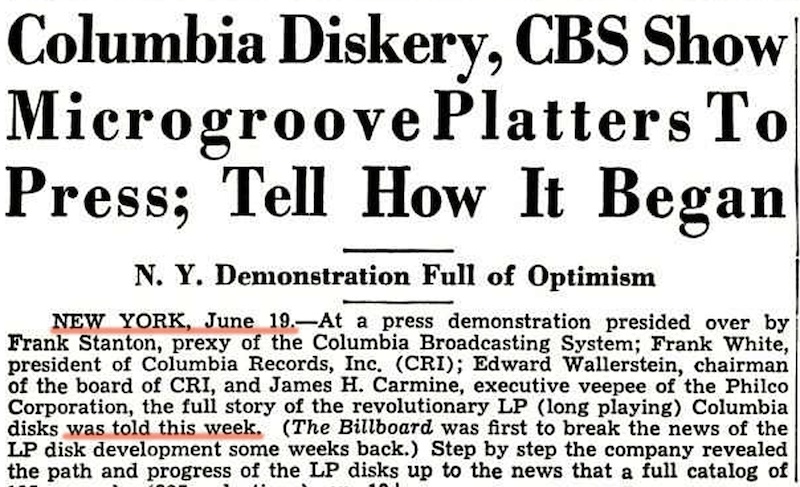
source: “Columbia Diskery, CBS Show Microgroove Platters To Press; Tell How It Began”, The Billboard, Vol.60, No.26, June 26, 1948, p.3
追記: さらに見つけました。Broadcasting Telecasting 誌 1948年6月28日号 p.74 の記事「SYMPHONY ON ONE RECORD: New Disc That Plays 22 1/2 Minutes on Each Side Shown By Columbia Records in New York」に、6月18日と明記されているのを確認 しました。
Update: I found another resource – on p.74 of June 28, 1948 issue of Broadcasting Telecasting magazine, in the article entitled “SYMPHONY ON ONE RECORD: New Disc That Plays 22 1/2 Minutes on Each Side Shown By Columbia Records in New York”, it surely reads as: “…was demonstrated in New York June 18 by Columbia Records Inc.,…”
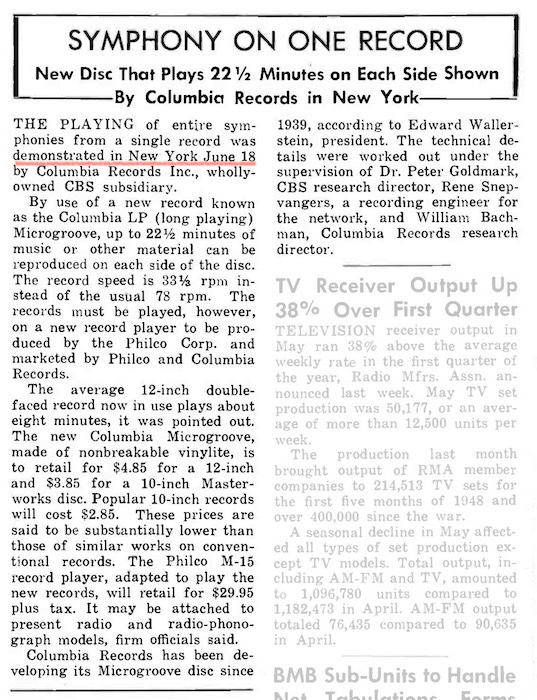
source: “SYMPHONY ON ONE RECORD: New Disc That Plays 22 1/2 Minutes on Each Side Shown By Columbia Records in New York”, Broadcasting Telecasting, Vol.34, No.26, June 28, 1948, p.74
この前後の模様については、当時の各種メディアで伝えられています。
Several media of the time reports the event itself, the story before/after the introduction of the LP.
11.1.1 The Billboard, Vol.60, No.22, May 29, 1948
6月18日のお披露目を前に、LP登場の噂をすっぱ抜いたのは Billboard 誌 1948年5月29日号 においてでした。以下、その冒頭部分を引用します。
Just before the debutante event, May 29, 1948 issue of The Billboard magazine became the first media that broke a story of Columbia’s development of Long Playing Microgroove records. Below is the opening paragraphs.

source: “Revolutionary Disk Marvel By Columbia: 30-Minute High-FIdelity”, The Billboard, Vol.60, No.22, May 29, 1945, p.3 & 20
Revolutionary Disk Marvel By Columbia: 30-Minute High-Fidelity
革命的で驚くべきレコード、コロムビアから:30分間の高品質再生
NEW YORK, May 22 – Columbia Records, Inc., is known to be preparing a brand-new wrinkle in phonograph records that conceivably may exert tremendous influence on the entire industry, from home record players thru library services. Opening gun in an intensive exploitation and promotion campaign on the new product is expected to coincide with the Columbia dealers’ convention in Atlantic City the week of June 21.
ニューヨーク発、5月22日 – コロムビアレコード (Columbia Records, Inc., CRI) は、家庭用レコードプレーヤから図書館サービスまで、蓄音機レコード業界全体に大きな影響を与える可能性のある、新たな展開を準備中であると言われている。この新製品に関する大々的なプロモーションの開始は、6月21日の週にアトランティックシティで開催されるコロムビア・ディーラー・コンベンションにあわせて行われる、と予想されている。
In the nature of a new disk marvel, the basic gimmick is said to be a micro-grooved vinylite disk in both 10 and 12-inch sizes, which would be aimed mainly at the home record market but could expand readily into other fields. The disks would operate at 33 1/3 r.p.m. and, depending on size would yield from 30 to 45 minutes on high-fidelity, wide-range music on each record (two sides).
この驚くべき新レコードは、10インチと12インチのヴィニライト製ディスクにマイクログルーヴで記録され、主に家庭用レコード市場をターゲットにしていると言われるが、他の分野にも容易に進出可能と思われる。このディスクは 33 1/3回転であり、ディスクのサイズにもよるが、1枚のレコードに両面で30分〜45分のハイファイでワイドレンジな音楽を収録可能である。
Since no home sets are equipped to run at the slow, e.t. speed, the diskery is known to be readying an entire unit for conjunction sale with the hush-hush platters. The unit reportedly will consist of a turntable and motor adapted for the lower speed, complete with a special head within an extra-light pick-up arm which is designed to fit the micro-grooved disks. This company adapter unit attaches quite simply to conventional phonographs and radios and will retail at about $300. It is understood that the combination of the unique pick-up arm and micro-grooved vinyl virtually eliminates all surface noise and affords tone reproduction superior to anything heretofore sold.
家庭用の再生機器には、(33 1/3回転という)低速動作の仕組みが備わっていないため、コロムビアレコードは、この極秘開発されたディスクとセットで販売する再生ユニットを準備していると言われている。このユニットは、低速用のターンテーブルとモーターで構成され、マイクログルーヴ盤に適合するよう設計された超軽量ピックアップアームと特別なヘッドを備えているとのこと。同社のアダプターユニットは、従来の蓄音機やラジオに容易に装着可能で、小売価格は300ドル程度になるとのこと。この独自のピックアップアームとマイクログルーヴ盤の組み合わせにより、サーフェスノイズを一掃でき、従来のレコードにはない優れた音色を再現できることが分かっている。
“Revolutionary Disk Marvel By Columbia: 30-Minute High-Fidelity”, The Billboard, May 29, 1948, Vol.60, No.22, p.3 & 2011.1.2 The Billboard, Vol.60, No.23, June 5, 1948
続く1948年6月5日号にも続報が多数載っています。
The following issue (June 5, 1948) also features some follow-up reports.
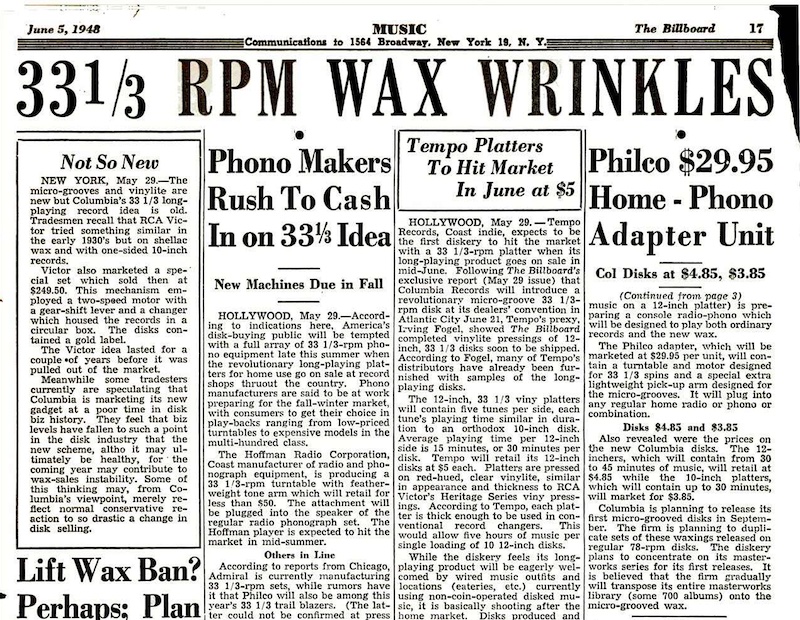
source: “33 1/3 RPM WAX WRINKLES”, The Billboard, Vol.60, No.23, June 5, 1948, p.3 & 17
Phono Makers Rush To Cash The Bonanza: First Platters in June
フォノメーカ、大当たりを目指し急ピッチで準備:レコード初リリースは6月か
NEW YORK, May 29. – New facts regarding the marketing of the micro-grooved long-playing Columbia vinylite disks (The Billboard, May 29) are coming to light. The Philco Radio & Television Corporation is now known to be the major firm readying an adapter unit which can convert home phonos for 33 1/3 rpm plays. It is understood that Philco (in a move to coincide with the initial promotion blast Columbia is expected to make on the 33 1/3 disks which play up to 45 minutes of music on a 12-inch platter) is preparing a console radio-phono which will be designed to play both ordinary records and the new wax.
ニューヨーク発、5月29日 – マイクログルーヴでヴィニライト製のコロンビア長時間レコード(5月29日号で報告済)の販売に関し、新しい事実が明らかになりつつある。Philco Radio & Television 社が、家庭用電蓄で 33 1/3回転盤を再生できるようにするアダプター・ユニットを準備している主要企業と判明した。Philco 社は、今回の Columbia 社による、12インチに45分間の音楽を収録可能な 33 1/3回転レコードの最初のプロモーションに合わせて、従来の(78回転の)レコードと、新しいレコードの両方を再生できるよう設計された、コンソールラジオ電蓄を準備していることが分かった。
The Philco adapter, which will be marketed at $29.95 per unit, will contain a turntable and motor designed for 33 1/3 spins and a special extra lightweight pick-up arm designed for the micro-grooves. It will plug into any regular home radio or phono or combination.
1台29.95ドルで販売される Philco のアダプターは、33 1/3回転用に設計されたターンテーブルとモーターに加え、マイクログルーヴ用に設計された特別な超軽量ピックアップアームを搭載している。通常の家庭用ラジオや電蓄、またはラジオ電蓄に接続して使用可能である。
“Phono Makers Rush To Cash The Bonanza: First Platters in June”, The Billboard, June 5, 1948, Vol.60, No.23, p.3 & 17あれ、さきほど上でみた 5月29日号では、アダプターは $300 って書かれてましたよね。。。けど、この6月5日号では $29.95 と書かれています。5月29日号の方が桁をひとつ間違えてしまったんでしょうかね。一般向けレコードプレーヤに(1948年当時の物価で)$300 ってのは、さすがに高すぎですしね。
Hmmm? The May 29 article reported that the adapter would retail at $300… but this June 5 article says the Philco adapter will be marketed at $29.95. It could be that the May 29 article (mistakenly) had an extra digit: $300 for a consumer turntable would be too expensive as a price at the time (1948).
Disks $4.85 and $3.85
レコードは $4.85 と $3.85 に
Also revealed were the prices on the new Columbia disks. The 12-inchers, which will contain from 30 to 45 minutes of music, will retail at $4.85 while the 10-inch platters, which will contain up to 30 minutes, will market for $3.85.
新しい Columbia 盤の価格も明らかになった。30〜45分の音楽を収録可能な12インチ盤は小売価格$4.85とされ、最大30分収録可能な10インチ盤は$3.85で販売される。
Columbia is planning to release its first micro-grooved disks in September. The firm is planning to duplicate sets of these waxings released on regular 78-rpm disks. The diskery plans to concentrate on its masterworks series for the first releases. It is believed that the firm gradually will transpose its entire masterworks library (some 700 albums) onto the micro-grooved wax.
Columbia はマイクログルーヴ盤の最初のリリースを9月に計画している。同社は通常の78回転盤アルバムセットと同じ内容(のマイクログルーヴ盤)のリリースを計画しており、当初は(クラシック用の)Masterworks シリーズのリリースに注力するとしている。最終的には同社の Masterworks シリーズ全アルバム(700セットあまりのアルバム)をマイクログルーヴ盤に移行させることになる。
“Phono Makers Rush To Cash The Bonanza: First Platters in June”, The Billboard, June 5, 1948, Vol.60, No.23, p.3 & 17一方、同誌には下のような懐疑的な意見も掲載されていました。古今東西、新しいテクノロジーが登場する時のお決まりではあります。
On the other hand, the issue also contains such “skeptical opinion” article as shown below – the same old thing in all time and places, that we often see when some new technology surfaces.
Not So New
目新しいものではない
NEW YORK, May 29. – The micro-grooves and vinylite are new but Columbia’s 33 1/3 long-playing record idea is old. Tradesmen recall that RCA Victor tried something similar in the early 1930’s but on shellac wax and with one-sided 10-inch records.
ニューヨーク発、5月29日 – マイクログルーヴ(による記録)とヴィニライト(の盤)、という側面は確かに新しいものだが、Columbia の 33 1/3回転長時間レコードというアイデアは昔からあるものだ。業界関係者は口々に、RCA Victor が1930年代初頭に類似の長時間レコード(ただしシェラック製で10インチ)に挑戦していたことを思い起こすと言う。
Victor also marketed a special set which sold then at $249.50. This mechanism employed a two-speed motor with a gear-shift lever and a changer which housed the records in a circular box. The disks contained a gold label.
Victor は当時 $249.50 のスペシャルセット(再生装置)も販売していた。ギアシフトレバー付き2スピードとディスクチェンジャー付きというメカニズムで、(当時の長時間レコードの)レーベルは金色で奢られていた。
The Victor idea lasted for a couple of years before it was pulled out of the market.
この Victor のアイデアは数年間続いたが、その後市場から撤退した。
Meanwhile some tradesters currently are speculating that Columbia is marketing its new gadget at a poor time in disk biz history. They feel that biz levels have fallen to such a point in the disk industry that the new scheme, altho it may ultimately be healthy, for the coming year may contribute to wax-sales instability. Some of this thinking may, from Columbia’s viewpoint, merely reflect normal conservative reaction to so drastic a change in disk selling.
一方、Columbia はレコード業界の歴史で悪い時期に新しいガジェットを売り出そうとしているのでは、と推測する業界関係者もいる。彼らは、現在レコード業界のビジネスレベルがここまで低下しているため、最終的には健全になるとしても、この新しいスキームがレコード販売を不安定にすることを助長しやしないか、と感じているようである。しかし Columbia の立場からみれば、(新しい材質、新しい技術の新しいレコードが登場することにより)レコード販売における急激な変化に対する、よくある保守的な反応にすぎない、とも言える。
“Not So New”, The Billboard, June 5, 1948, Vol.60, No.23, p.17ここで触れられている「RCA Victor が1930年代初頭に類似の長時間レコードに挑戦」というのは、本稿 Pt.4 セクション 4.2 で紹介した “Program Transcription” 盤です。マイクログルーヴではなく、10インチ盤はシェラック製、12インチ盤はヴィニライト(Victrolac)製、後者では片面最長15分収録可能、というものでした。
The gadget that “RCA Victor tried something similar in the early 1930’s” was, as I previously mentioned in the Pt.4 Section 4.2, a Program Transcription record. It was not microgroove; 10-inch shellac disc, or 12-inch vinylite (Victrolac) disc; 12-incher contained fifteen minutes of music on one side.
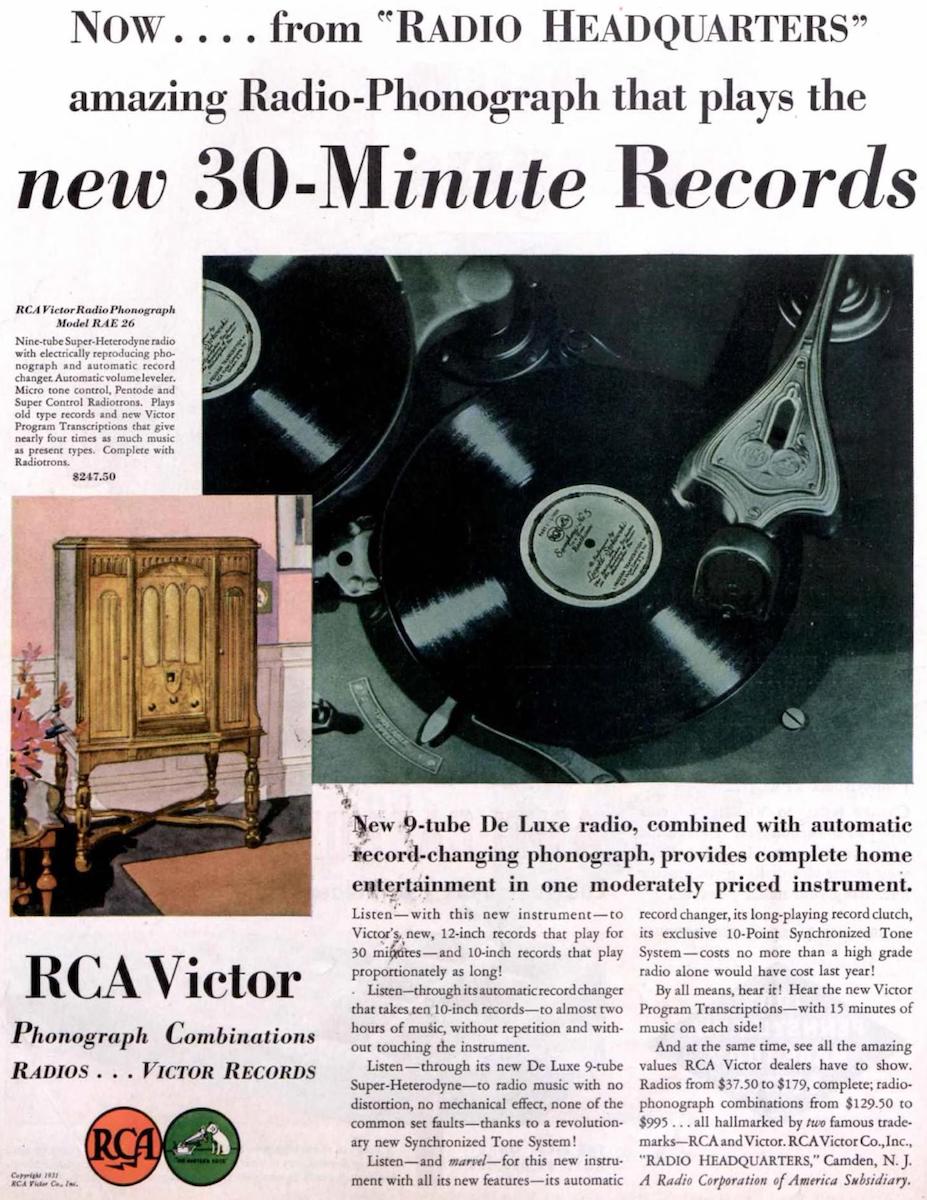
source: RCA Victor brouchure, 1931, archived at hifi-archiv.info
1931年のRCA Victorのパンフレット、78rpm + 33 1/3rpm 両対応の民生用蓄音機 Radiola Automatic Electrola RAE-26 も掲載
RCA Victor brochure from 1931: also featuring Radiola Automatic Electrola RAE-26, compatible both with 78rpm and 33⅓ rpm
1931〜1933年当時は、軽針圧のピックアップ/トーンアームではなかった(約150g〜200g)ために、数回再生しただけで盤が劣化してしまい、多数クレームが発生したため、市場から撤退させた、という話でした。その後、Pt.6 セクション 6.3 で紹介したように、Hunt & Pierce 両氏によって、戦前に超軽針圧ピックアップの研究開発(と針の側壁サポート)が進んだこともあり、戦後のマイクログルーヴLP開発に繋がった、という経緯がありました。
In 1931~1933, when RCA Victor’s Program Transcription Records were sold, there was no “light-weight” pickups (tracking force was normally 150g to 200g): the discs easily get worned out just after several playback. After that, the works of Hunt and Pierce regarding “the development of ultra light-weight pickups for high-fidelity, low-noise reproduction with long service life” (as mentioned in the Pt.6 Section 6.3), as well as “groove’s side-wall support of the stylus”, contributed the later development of Long Playing Microgroove records.
その他、この The Billboard 1948年6月5日号では、ターンテーブル(レコードプレーヤ)製造メーカの反応についての記事も掲載されています。上述した Philco のアタッチメント(33 1/3回転マイクログルーヴ盤専用プレーヤ)の他、Philco はデュアルスピード(78回転と33 1/3回転)で2アームの大型プレーヤを製造中のほか、Hoffman Radio 社も、Philco アタッチメントと同様の 33 1/3回転ターンテーブルと軽量トーンアームのセットを製造中で、$50 以下で販売予定、と報告されています。
Other article presents the reaction from phono equipment manufacturers: Philco’s attachment (33 1/3 rpm turntable and light pickup) as mentioned above; Philco’s larger models containing dual motor systems with separate tone arms; Hoffman Radio Corporation’s 33 1/3 rpm turntable with “feather-weight” tonearm, which will retail for less than $50.
11.1.3 The Billboard, Vol.60, No.26, June 26, 1948
そして、ウォルドルフ・アストリア ホテルにおける LP お披露目の直後、The Billboard 誌はその模様を早速レポートしています。
Then soon after the press demonstration at the Waldorf-Astoria Hotel, The Billboard magazine was one of the firsts reporting the historic event.
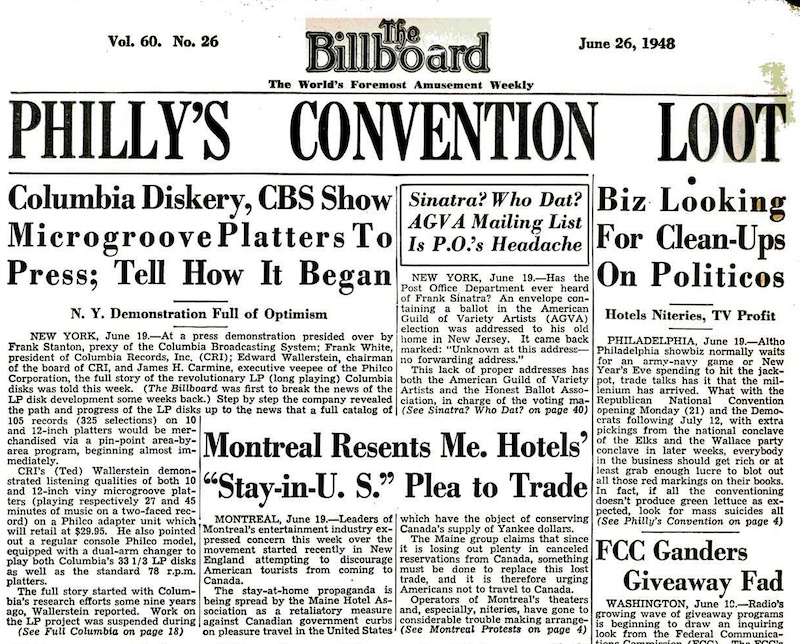
source: “Columbia Diskery, CBS Show Microgroove Platters To Press; Tell How It Began”, The Billboard, Vol.60, No.26, June 26, 1948, p.3, 18 & 21
Columbia Diskery, CBS Show Microgroove Platters To Press; Tell How It Began
Columbia レコードと CBS、マイクログルーヴ盤をプレスにお披露目;誕生秘話を語る
N.Y. Demonstration Full of Optimism
ニューヨークでのデモンストレーション、楽観的な雰囲気で満たされる
NEW YORK, June 19. – At a press demonstration presided over by Frank Stanton, prexy of the Columbia Broadcasting System; Frank White, president of Columbia Records, Inc. (CRI); Edward Wallerstein, chairman of the board of CRI, and James H. Carmine, executive veepee of the Philco Corporation, the full story of the revolutionary LP (long playing) Columbia disks was told this week. (The Billboard was first to break the news of the LP disk development some weeks back.) Step by step the company revealed the path and progress of the LP disks up to the news that a full catalog of 105 records (325 selections) on 10 and 12-inch platters would be merchandised via a pin-point area-by-area program, beginning almost immediately.
ニューヨーク発、6月19日 – Columbia Broadcasting System (CBS) の社長 Frank Stanton 氏、Columbia Records, Inc. (CRI) の社長 Frank White 氏、CRI の取締役会長 Edward Wallerstein 氏、Philco Corporation の重役 James H. Carmine 氏主催の、今週執り行われたプレス・デモンストレーションの場において、革命的な LP(長時間再生)コロムビアレコードの全容が明らかにされた(LPレコード開発のニュースを最初に伝えたのは、数週間前の本誌においてである)。LP レコードの道のりと経過について、段階を追って明らかにされ、最後は10インチ盤と12インチ盤による105枚のレコードの全カタログ(325楽曲)が、各地方ごとにピンポイントで商品化され即座に販売を開始される、というニュースで締めくくられた。
CRI’s (Ted) Wallerstein demonstrated listening qualities of both 10 and 12-inch viny microgroove platters (playing respectively 27 and 45 minutes of music on a two-faced record) on a Philco adapter unit which will retail at $29.95. He also pointed out a regular console Philco model, equipped with a dual-arm changer to play both Columbia’s 33 1/3 LP disks as well as the standard 78 r.p.m. platters.
CRI (Columbia Records) の Wallerstein 氏が、10インチと12インチのヴァイナル製マイクログルーヴ盤(それぞれ両面で27分と45分を収録)を再生し、音質のデモを行った。このデモは、$29.95 で販売される予定の Philco アダプタ(ターンテーブル)で行われた。また Wallerstein 氏は通常の Philco コンソールモデルについても触れた。こちらは2アームでオートチェンジャー付、Columbia の 33 1/3回転 LP と、従来の 78回転盤の両方が再生できる。
“Columbia Diskery, CBS Show Microgroove Platters To Press; Tell How It Began”, The Billboard, June 26, 1948, Vol.60, No.26, p.3,18,21以下、Wallerstein 氏がプレスに述べた、LP開発について説明が掲載されています。また、LP初お披露目を象徴する、大量の78回転アルバムとLPアルバムとの比較シーンについても触れられています(この写真が掲載されている別雑誌の記事はのちほど紹介します)。
Following is the full story of Columbia’s LP development, as reported by Mr. Wallerstein himself. Also, a famous presentation – a stacked pile of 78rpm albums – compared with equivalent LP albums – is mentioned here (the photo capturing this scene will be mentioned in the following section, from another magazine).
The full story started with Columbia’s research efforts some nine years ago, Wallerstein reported. Work on the LP project was suspended during the war and then resumed about three years ago. Under the guidance of CBS Research Director Peter Goldmark, assisted by Rene Snepvangers, CBS engineer, and William Bachman, CRI research director, the LP microgroove record potential was realized this year.
LP開発は、約9年前の Columbia の研究活動から全てが始まった、と Wallerstein 氏は報告した。LP 開発プロジェクト作業は、第二次大戦中に中断され、約3年前から再開された。CBS の研究部長 Peter Goldmark 指揮のもと、CBS のエンジニア René Snepvangers 氏や Columbia の主任研究員 William Bachman 氏の協力により、長時間マイクログルーヴ盤の可能性が今年現実のものとなった。
According to Wallerstein, the company’s main plant at Bridgeport, Conn., for several months has been pressing the new LP’s for nationwide distribution. The attendant savings in storage space were graphically demonstrated by comparing a pile of 101 standard albums with the comparable LP catalog of 101 records. The albums required nearly eight feet of storage space, the LP records little more than one foot. Wallerstein stressed that the LP viny record was “full range, undistorted quality and a hitherto unachieved fidelity.”
Wallerstein 氏によると、コネチカット州ブリッジポートにある本社プレス工場では、この数ヶ月間、新しいLPレコードをプレスし、全国への配布に備えているとのこと。また、(長時間収録レコードによるメリットとして)レコード収納スペースが大幅に節約できることが、(従来の78回転盤のバインダー式)アルバム101タイトルと、101枚のLPアルバムの現物を使ったデモンストレーションで示された。結果、(78回転)アルバムを積み上げると 8フィート(約2.4メートル)近くになるのに対し、LPレコードでは1フィート(約30cm)程度であった。そして Wallerstein 氏は、ヴァイナル製LPレコードが「フルレンジ、歪のない品質、これまでは達成できなかった忠実な音質」を備えている、と強調した。
“Columbia Diskery, CBS Show Microgroove Platters To Press; Tell How It Began”, The Billboard, June 26, 1948, Vol.60, No.26, p.3,18,2178回転盤の代替としての新メディア、LPレコード。その誕生は、やはり「過去の遺産との互換性」および「費用対効果」を重要視したものだったことが語られます。
LP records, the new media that would replace regular 78rpm records – it was told that “compatibility”, “cost-effectiveness” and “utilization of existing equipment” was the key factor when Columbia finally adopted discs, not tapes and wires.
He revealed that film, tape, wire-recording 16-inch transcriptions and other systems were carefully investigated before the LP microgroove system was adopted. “We decided to concentrate upon the development of a record which would combine all the long-playing qualities of these methods and at the same time improve its fidelity of reproduction, ease of use, and above all, enable it to be marketed at a price far lower than any of the aforementioned systems. Furthermore, and perhaps of paramount importance, the LP microgroove records do not make obsolete the millions of dollars’ worth of records and equipment the public already owns. The new records allow for a gradual transition at little or no expense. Either tape or wire recording would have tended to make existing equipment obsolete.”
LPマイクログルーヴ方式の採用が決定されるまでに、フィルム、テープ、ワイヤー録音、16インチトランスクリプション盤、その他さまざまな方式を慎重に検討した、と Wallerstein 氏が明らかにした。「そして、これらすべての方式が持つ長時間録音という特質をすべて兼ね備え、同時に、忠実再生の向上と使いやすさを備え、そして何よりも、前述のどの方式よりもはるかに廉価で販売できる、そんなレコードの開発に集中することとした。さらに、おそらく最も重要な点であるが、マイクログルーヴLPレコードが登場することで、すでに(大衆が)所有している数百万ドル相当のレコードコレクションや再生機材を陳腐化させない、ということである。この新しいレコードは、ほとんど費用をかけることなく、徐々に移行させることが可能である。テープ録音やワイヤー録音の場合は、既存の機器がそのまま使えないことになる。
“Columbia Diskery, CBS Show Microgroove Platters To Press; Tell How It Began”, The Billboard, June 26, 1948, Vol.60, No.26, p.3,18,21さらに、このプレス発表に Columbia / CBS と共に登壇していた Philco 社の James H. Carmine 氏が、LP再生用機器(アタッチメント)について説明を行いました。
Furthermore, along with prexies of Columbia / CBS, Philco’s James H. Carmine presented Philco’s reproducing turntable (attachment) for LP reords.
Philco Reproducer
Philco 社の再生機器
In conjunction with the CRI announcement, James H. Carmine pointed up the Philco development of an “equally revolutionary” balanced fidelity reproducer which complements the microgroove records. Carmine stated that the 1949 line of Philco radio-phonographs includes a full series of models designed to play both the new microgroove records and standard records. He also presented the Model M-15 album-length record player (adapter unit) which can play the LP records thru the speaker and amplifier system of any radio or phonograph.
Columbia Records (CRI) のアナウンスと併せて、James H. Carmine 氏は、マイクログルーヴ盤を補完する「同様に革命的な」 Philco のバランス・フィデリティ再生機器について強調気味に話した。Carmine 氏は、1949年の Philco ラジオ電蓄ラインアップは、全シリーズで新しいマイクログルーヴ盤と従来のレコードの両方を再生可能にしている、と述べた。また、LPレコードをラジオや蓄音機のスピーカやアンプで再生可能にする、Model M-15 Album-Length Record Player(アダプターユニット)も紹介した。
Reproducer Vital to LP
LPに不可欠な再生機器
Carmine indicated that a vital part of LP reproduction was achieved by Philco’s “balanced fidelity reproducer.” The reproducer used the lightest pick-up yet devised (1/5 ounce pressure on the disk) and its tracking pressure is so low and so stable that it has 10 times greater ability to respond to the minute variations of the microgrooves. It gives a wider range of “highs” and “lows” than ever before but attains an alleged almost complete freedom from surface noise and record scratch. The heart of the reproducer is an armored crystal, hermetically sealed against moisture, which is hinged to the tone arm with a shock-absorbing mounting which gives it complete freedom of movement. The needle is an extra-fine steel alloy permanent point which is replaceable.
Carmine 氏は、LP再生に決定的な役割を果たす(再生機器が)、Philco 社の「Balanced Fidelity Reproducer」によって達成された、と指摘した。この再生機器は、これまでに考案されたピックアップの中で最も軽針圧(1/5オンス≒5.6g)なものを使用しており、トラッキング圧は非常に低く、また非常に安定しているため、マイクログルーヴ盤の溝の微細な変化に対応する能力は10倍以上である。高音域、低音域共に、従来よりワイドレンジで、サーフェスノイズやスクラッチノイズの影響をほとんど受けないされる。再生機器の心臓部であるクリスタル素子は、湿気に強い密閉型であり、衝撃吸収マウントを介してトーンアームに固定され、(溝トレース時に)自由に動作する。針は極細のスチール合金製であり、交換可能となっている。
“Columbia Diskery, CBS Show Microgroove Platters To Press; Tell How It Began”, The Billboard, June 26, 1948, Vol.60, No.26, p.3,18,21この記事で紹介されている、6月18日の Columbia / CBS のお披露目の場で同時に登場した、Philco のアダプタ(ターンテーブル) は M-15 Album-Length Record Player で、これが世界初の市販用マイクログルーヴ盤用プレーヤということになります。当時の付属品(マニュアル等)全てが揃った、ほぼ未使用に近い完動品のデモを行う動画を発見したので、引用します。この動画の中で紹介されている個体は、1949年5月12日に販売されたレシートも付属しており、$8.50 と書かれています。
The Philco adapter (turntable unit) as appeared on this article is, M-15 Album-Length Record Player, world’s first consumer turntable for microgroove records, and it was premiered on this June 18 presentation along with Columbia / CBS’s LP records. I found the YouTube video demonstrating this vintage turntable in action (beautiful new old stock and perfectly working – even with all manuals and even a receipt, indicating this particular unit was sold on May 12, 1949, at $8.50!) – here it is:
ところで、この世界初のLP再生装置で使われているピックアップは、上の記事にある通り、マグネットカートリッジではなく、圧電型のクリスタルカートリッジでした。プロフェッショナルユース(放送局)ではマグネットカートリッジが使われていたものの、当時はやはり民生用では圧電型カートリッジが圧倒的に主流であったことが伺えます。
By the way, the pickup used for this world’s first LP player was, as mentioned in the above news article, a crystal (piezoelectric) cartridge, not a magnetic cartridge – this suggests that crystal cartridges were major pickups for consumer equipments in the late 1940s.
1948年6月に発表された1949年版 Philco 製品カタログ は、以下のサイトで見ることができます。p.6〜p.16 が、すべて LP 用ターンテーブル、およびターンテーブルを装備したラジオシステムとなっています。
Philco’s 1949 Product Catalog (published in June 1948) can be read at the following webpage. Pages 6 thru 16 feature LP turntables, as well as radio-phonograph systems.
11.1.4 Broadcasting Telecasting, Vol.34, No.26, June 28, 1948
放送局業界向けの Broadcasting Telecasting 誌の1948年6月28日号でも、6月18日の LP のプレス向けデモが紹介されています。
June 28, 1948 issue of the Broadcasting Telecasting magazine also introduces the press demonstration of June 18, 1948.

source: “SYMPHONY ON ONE RECORD: New Disc That Plays 22 1/2 Minutes on Each Side Shown By Columbia Records in New York”, Broadcasting Telecasting, Vol.34, No.26, June 28, 1948, p.74
THE PLAYING of entire symphonies from a single record was demonstrated in New York June 18 by Columbia Records Inc., wholly-owned CBS subsidiary.
CBS の完全所有子会社である Columbia Records 社によって、1枚のレコードから交響曲全編を再生するデモが、6月18日にニューヨークで行われた。
By use of a new record known as the Columbia LP (long playing) Microgroove, up to 22 1/2 minutes of music or other material can be reproduced on each side of the disc. The record speed is 33 1/3 rpm instead of the usual 78 rpm. The records must be played, however, on a new record player to be produced by the Philco Corp. and marketed by Philco and Columbia Records.
Columbia LP (長時間) マイクログルーヴと呼ばれる新しいレコードを使うことで、ディスクの片面で22分半の音楽(やその他の音源)が再生される。ただしこの新しいレコードは、Philco 社が製造し、Philco 社と Columbia 社が販売する、新しいレコードプレーヤでしか再生できない。
The average 12-inch double-faced record now in use plays about eight minutes, it was pointed out. The new Columbia Microgroove, made of nonbreakable vinylite, is to retail for $4.85 for a 12-inch and $3.85 for a 10-inch Masterworks disc. Popular 10-inch records will cost $2.85. These prices are said to be substantially lower than those of similar works on conventional records. The Philco M-15 record player, adapted to play the new records, will retail for $29.95 plus tax. It may be attached to present radio and radio-phonograph models, firm officials said.
現在使われている(78回転の)12インチ両面盤では、両面で約8分間の再生にとどまる、と指摘された。この新しい Columbia マイクログルーヴは、割れにくく丈夫なヴィニライト製であり、(クラシックの)Masterworks シリーズでは 12インチが $4.85、10インチが $3.85 で販売される。ポピュラー向けの10インチ盤は $2.85 となる。この販売価格は、同等の音源を収めた従来の盤に比べて十分に廉価である、と述べられた。Philco 社製の M-15 レコードプレーヤを使ってこの新しいレコードが再生できるが、こちらは $29.95(税抜)で販売されることになっている。この新型レコードプレーヤは、既存のラジオ、またはラジオ電蓄に接続して使用可能であると述べられた。
Columbia Records has been developing its Microgroove disc since 1939, according to Edward Wallerstein, president. The technical details were worked out under the supervision of Dr. Peter Goldmark, CBS research director, Rene Snepvangers, a recording engineer for the network, and William Bachman, Columbia Records research director.
社長の Edward Wallerstein 氏によると、Columbia 社はマイクログルーヴ盤の開発を1939年から行ってきたとのこと。技術的な詳細は、CBS研究部長の Peter Goldmark 博士の監督のもと、CBS の録音エンジニア René Snepvangers 氏、Columbia Records の研究部長 William Bachman 氏によって開発が進められた。
“SYMPHONY ON ONE RECORD: New Disc That Plays 22 1/2 Minutes on Each Side Shown By Columbia Records in New York”, Broadcasting Telecasting, Vol.34, No.26, June 28, 1948, p.7411.1.5 LIFE Magazine, Vol.25, No.4, July 26, 1948
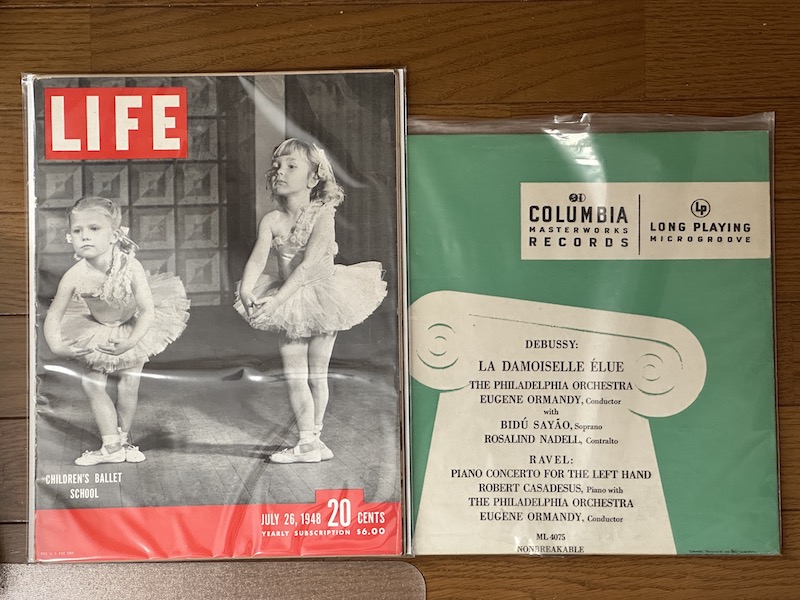
Front cover of LIFE magazine, July 26, 1948, Vol.25, No.4.
そして、プレス向けお披露目会の1ヶ月後、一般向けグラフ雑誌として有名な LIFE誌 の1948年7月26日号に、プレス発表の模様が2ページに渡って掲載 されます。縦が約14インチ、横が約10.5インチと大判で、かつ写真を多数掲載するLIFE誌らしく、そのプレスの際に誇らしげに展示された、78回転盤アルバムとLPの比較写真が、大きく掲載されています。
Then a month after the June 18 Demonstration, July 26, 1948 issue of the famous weekly photo-news magazine LIFE (approximately 10.5″w x 14″h) featured the press demonstration in two pages. It featured several photographs, including the famous graphical demonstration of comparing 78rpm albums and LP albums.
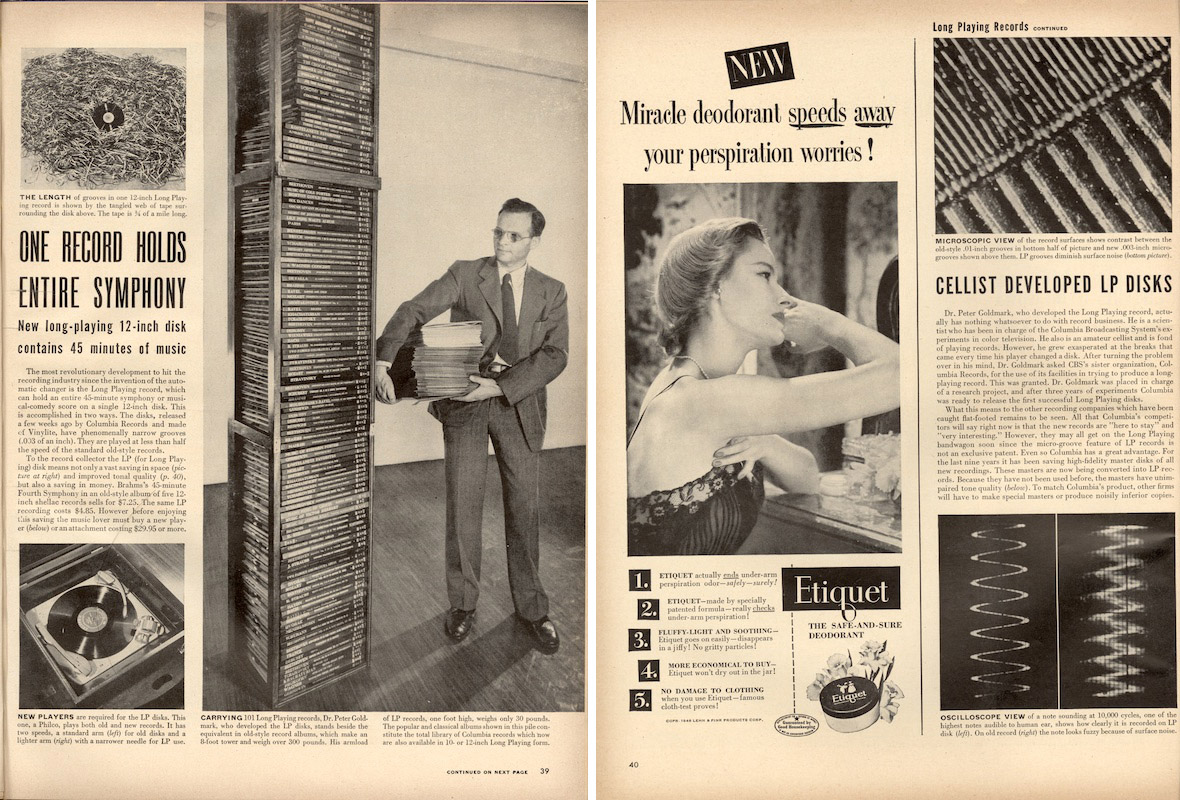
source: LIFE Magazine, July 26, 1948, pp.39-40
LIFE誌1948年7月26日号でLP誕生を伝える記事
ONE RECORD HOLDS ENTIRE SYMPHONY: New long-playing 12-inch disk contains 45 minutes of music
1枚のレコードに交響曲を全編収録: 新しい長時間12インチ盤に45分間の音楽
The most revolutionary development to hit the recording industry since the invention of the automatic changer is the Long Playing record, which can hold an entire 45-minute symphony or musical-comedy score on a single 12-inch disk. This is accomplished in two ways. The disks, released a few weeks ago by Columbia Records and made of Vinylite, have phenomenally narrow grooves (.003 of an inch). They are played at less than half the speed of the standard old-style records.
オートチェンジャーの発明以来、レコード業界を襲った最も革命的な開発は、この長時間(Long Playing)レコードである。1枚の12インチ盤に、45分間の交響曲やミュージカルコメディなどをそのまま収録できる。これは、2つの方法で実現されている。まず1つは盤そのもので、数週間前に Columbia からリリースされたものだが、ヴィニライト製であり、驚異的に狭い(0.003インチ)溝で記録されている。次に、従来の(78回転の)レコードの半分以下の速度で再生される。
To the record collector the LP (for Long Playing) disk means not only a vast saving in space (picure at right) and improved tonal quality (p.40), but also a saving in money. Brahms’s 45-minute Fourth Symphony in an old-style album of five 12-inch shellac records eslls for $7.25. The same LP recording costs $4.85. However before enjoying this saving the music lover must buy a new player (below) or an attachment costing $29.95 or more.
レコードコレクターにとっては、LP盤(Long Playing の略)は、収納スペースの大幅な節約(右写真)と音質の向上(p.40参照)だけでなく、コスト削減も意味する。例えばブラームスの交響曲第4番(45分間)は、12インチシェラック盤5枚組の旧式アルバムでは $7.25 であるが、同内容の LP盤では $4.85 となる。しかし、これらのメリットや削減・節約を享受する前に、音楽愛好家は新型のプレーヤ(下写真)、または $29.95 以上するアタッチメントを買わなければならない。
“ONE RECORD HOLDS ENTIRE SYMPHONY: New long-playing 12-inch disk contains 45 minutes of music”, LIFE, July 28, 1948, Vol.25, No.4, pp.39-40この、10インチ/12インチの78回転アルバム101セットを山のように積んだ横で、同内容の10インチ/12インチLPを抱える、Goldmark 氏の写真が当時読者に与えたインパクトは、絶大なものだったことでしょう。特に長時間の楽曲が多いクラシック音楽のレコードコレクターにとっては。
I guess the photo of Dr. Goldmark carrying 101 LP records standing beside the 8-feet pile of 78rpm albums definitely gave big impact to the people at the time – especially to the record collectors of Classical music.
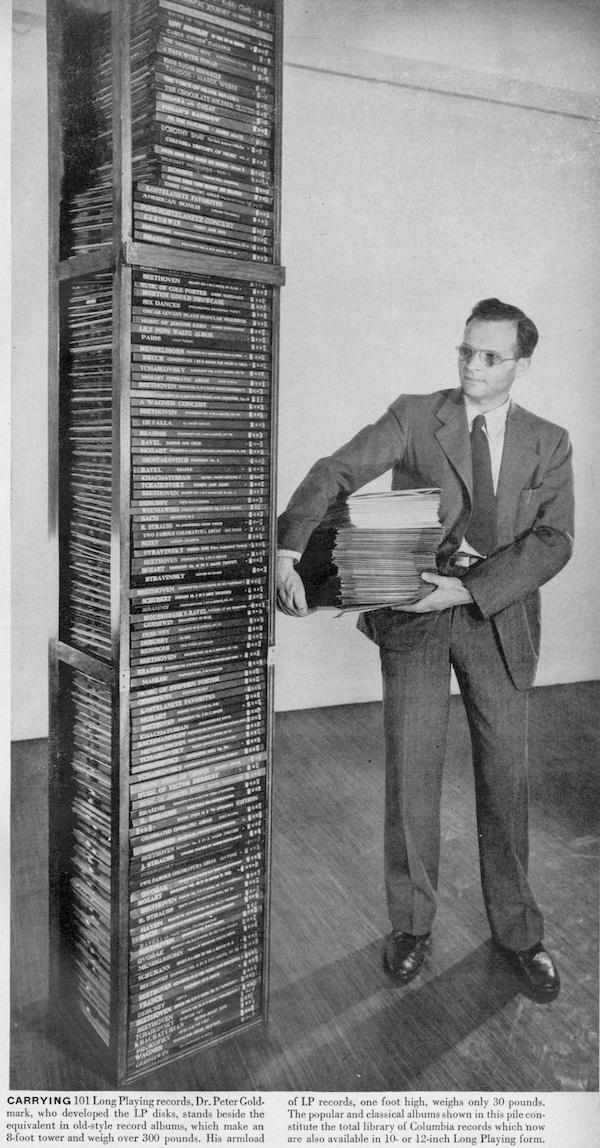
source: LIFE Magazine, July 26, 1948, p.39
Caption: “CARRYING 101 Long Playing records, Dr. Peter Goldmark, who developed the LP disks, stands beside the equivalent in old-style record albums, which make an 8-foot tower and weigh over 300 pounds. His armload of LP records, one foot high, weighs only 30 pounds. The popular and classical albums shown in this pile constitute the total library of Columbia records which now are also available in 10- or 12-inch Long Playing form.”
キャプション: 「抱えているのは101枚のLPレコード。そのLPレコードを開発した Peter Goldmark 博士が、同内容を収録した旧式の(78回転盤)レコードアルバムの横に立つ姿である。積み上げられた後者は8フィート (2.43m)にもなり、重量は 300ポンド (136kg) 超にも達する。博士が腕に抱えるLPレコードは、全て重ねても 1フィート (30cm) ほどであり、たったの 30ポンド (13.6kg) にしかならない。この山積みにされたポピュラー/クラシック(78回転盤)アルバムは、まさに Columbia レコードが 10インチおよび12インチの LP フォーマットでも提供を開始した、全ライブラリである。」
“ONE RECORD HOLDS ENTIRE SYMPHONY: New long-playing 12-inch disk contains 45 minutes of music”, LIFE, July 28, 1948, Vol.25, No.4, p.39ちなみに、この Goldmark 氏と山積みのアルバムの写真には別テイクがあり、Getty Images で4枚拝むことができます。Getty Images 上のボードにまとめておきました のでご覧ください(当ブログに埋め込みを許可されていない写真のためリンクのみ)。
Alternate photos of the Goldmark standing beside a pile of 78rpm albums are known to exist. At least four more photos are available on the Getty Images website – I have compiled these four photos into the Getty Images board (it is prohibited to embed these photos to personal blogs without buying licenses).
なお、以下に掲載する写真は、The New York Times 誌の1988年6月5日号に掲載された特集記事「To the LP At 40: Hail! (And Farewell?)」に掲載されたものです。
By the way, the following photo was taken from June 5, 1988 issue of The New York Times, in the article entitled “To the LP At 40: Hail! (And Farewell?)”.
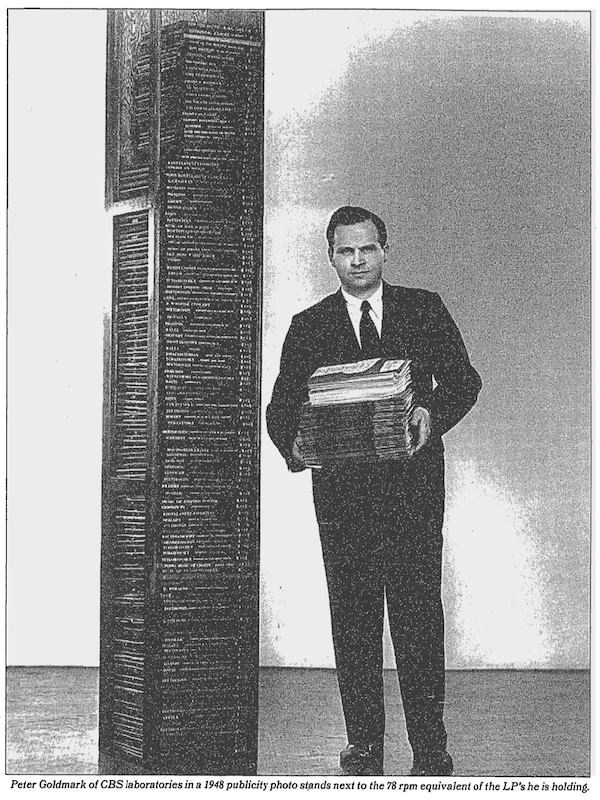
source: “SOUND AND RECORDINGS; To the LP At 40: Hail! (And Farewell?)”, by David Hamilton, The New York Times, June 5, 1988, p.29 & 32.
また、このページの左上には、LP盤1枚と、そこに刻まれた音溝の長さと同等のオープンリールテープ(を引き出してぐちゃぐちゃに置いたもの)との比較写真が掲載されています。
Also featured is the photo of an LP record and the tangled web of tape, showing the equivalent length of the micro-groove of the LP.
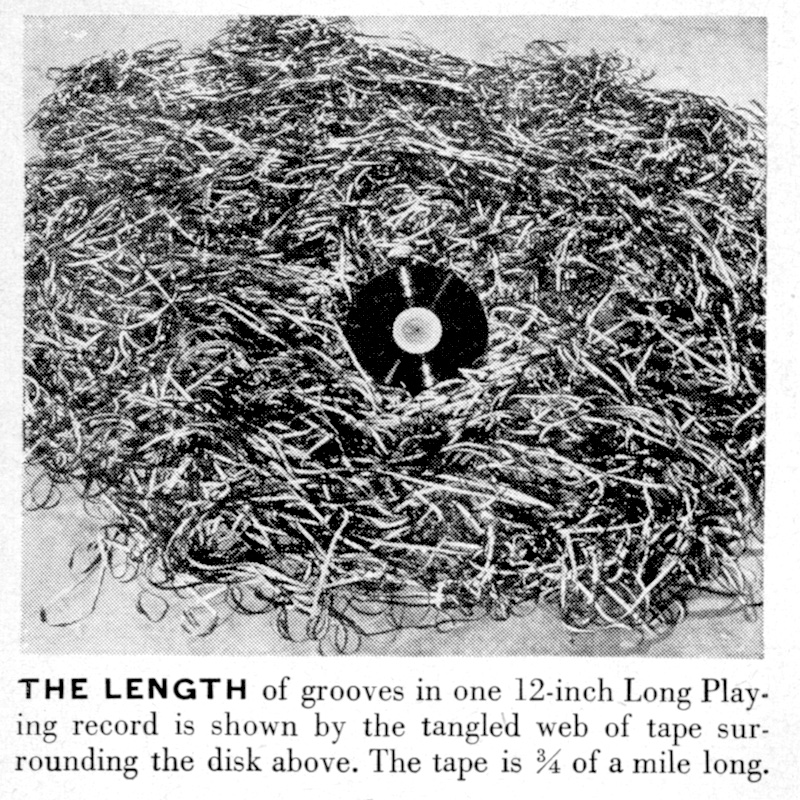
source: LIFE Magazine, July 26, 1948, p.39
Caption: “THE LENGTH of grooves in one 12-inch Long Playing record is shown by the tangled web of tape surrounding the disk above. The tape is 3/4 of a mile long.”
キャプション:「12インチLPレコードに刻まれた溝の 長さ を、絡まり合うように置かれたテープで表現するとこうなる。このテープの長さは 3/4 マイル(約1.2km)である。」
“ONE RECORD HOLDS ENTIRE SYMPHONY: New long-playing 12-inch disk contains 45 minutes of music”, LIFE, July 28, 1948, Vol.25, No.4, pp.39-40次のページでは、LP開発における最重要人物として Peter Goldmark 氏による開発秘話が誇らしげに掲載されています。
Following page proudly presents the story behind the LP development, and the story of the developer of the LP, Peter Goldmark.
CELLIST DEVELOPED LP DISKS
チェリストがLP盤を開発
Dr. Peter Goldmark, who developed the Long Playing record, actually has nothing whatsover to do with record business. He is a scientist who has been in charge of the Columbia Broadcasting System’s experiments in color television. He also is an amateur cellist and is fond of playing records. However, he grew exasperated at the breaks that came every time his player changed a disk. After turning the problem over in his mind, Dr. Goldmark asked CBS’s sister organization, Columbia Records, for the use of its facilities in trying to produce a long-playing record. This was granted. Dr. Goldmark was place in charge of a research project, and after three years of experiments Columbia was ready to release the first successful Long Playing disks.
長時間レコードを開発した Peter Goldmark 博士は、実はレコードビジネスとは何の関係もない人物である。彼は、コロムビア放送システム (Columbia Broadcasting System, CBS) でカラーテレビの実験・研究に従事する科学者である。Goldmark 博士はまたアマチュアのチェロ奏者でもあり、レコード再生も好む人物である。ところが、、彼のレコードプレーヤ(オートチェンジャー電蓄)が、盤を切り替える度に再生が途切れることに苛立ちを覚えるようになった。そこで Goldmark 博士は、CBS の姉妹会社である Columbia レコード社に、「長時間レコードを作りたいので、設備を使わせて欲しい」と頼み込み、結果それが認められたのだ。Goldmark 博士は(LPの)開発プロジェクトの責任者となり、その後3年の歳月を実験に費やしたのち、この度 Columbia が初めて長時間レコードを世に送り出すことができたのである。
What this means to the other recording companies which have been caught flat-footed remains to be seen. All that Columbia’s competitors will say right now that the new records are “here to stay” and “very interesting.” However, they may all get on the Long Playing bandwagon soon since the micro-groove feature of LP records is not an exclusive patent. Even so Columbia has a great advantage. For the last nine years it has been saving high-fidelity master disks of all new recordings. These masters are now being converted into LP records. Because they have not been used before, the masters have unimpaired tone quality (below). TO match Columbia’s product, other firms will have to make special masters or produce noisily inferior copies.
このことが、足元をすくわれた他のレコード会社にとって、どのような意味を持つか、はまだ分からない。Columbia の競合他社が今言えることは、この新しいレコードは「これからの時代を担う」し「非常に興味深い」、ということだけであろう。しかし、LPレコードのマイクログルーヴは独占特許ではないので、すぐに全社が長時間レコードの流行に乗ってくるかもしれない。それでも、Columbia には依然大きなアドバンテージがある。過去9年間、Columbia は全ての新譜の高忠実度マスターディスクを保存しており、これをそのままLPレコードに変換する。これらは未使用であるため、音質が全く損なわれていないマスターである(下図を参照)。他のレーベルが Columbia に匹敵するためには、特別な原盤を作るか、またはノイズの多い劣悪な(盤から盤起こしして)コピーを作るしかない。
“ONE RECORD HOLDS ENTIRE SYMPHONY: New long-playing 12-inch disk contains 45 minutes of music”, LIFE, July 28, 1948, Vol.25, No.4, pp.39-40このページには、マイクログルーヴLP盤の溝、そして従来の(ワイドグルーヴ)78回転盤の溝、を比較した写真が掲載されています。
This page feature an interesting photo of a microscopic view of the record surfaces, comparing the grooves of a microgroove LP record, and that of regular (widegroove) 78rpm record.

source: LIFE Magazine, July 26, 1948, p.40
LIFE誌1948年7月26日号に掲載されたLP登場の記事より。マイクログルーヴLP盤の溝と、従来の78回転盤の溝を比較した写真
Caption: “MICROSCOPIC VIEW of the record surfaces shows contrast between the old-style .01-inch grooves in bottom half of picture and new .003-inch microgrooves shown above them. LP grooves diminish surface noise.”
キャプション:「顕微鏡で捉えた レコード盤の表面。従来の(78回転盤の) 0.01インチの溝が写真の下で、新しい0.003インチの微細な溝が上に示されている。LPの溝はサーフェスノイズを減少させる。」
“ONE RECORD HOLDS ENTIRE SYMPHONY: New long-playing 12-inch disk contains 45 minutes of music”, LIFE, July 28, 1948, Vol.25, No.4, pp.39-40また、78回転盤よりサーフェスノイズが少なく、より高い周波数帯域までよどみなく再生できる、として、オシロスコープの波形も掲載されています。
This page also features a photo of waveform (by oscilloscopes) to prove the new media has less surface noise (and contains higher frequency range) compared with regular 78rpm records.
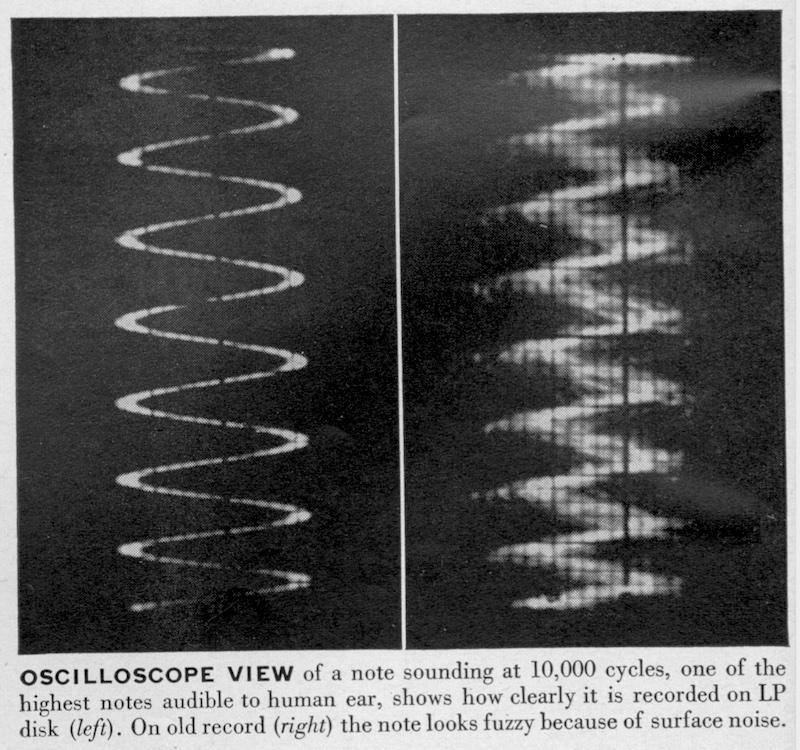
source: LIFE Magazine, July 26, 1948, p.40
Caption: “OSCILLOSCOPE VIEW of a note sounding at 10,000 cycles, one of the highest notes audible to human ear, shows how clearly it is recorded on LP disk (left). On old record (right) the note looks fuzzy because of surface noise.”
キャプション:「オシロスコープで捉えた 10,000Hz の音の波形。これは、人間が知覚可能な高い方の音である。この波形から、LP盤(左)ではいかにクリーンに記録されているかがうかがえる。一方で、従来のレコード(右)では、サーフェスノイズのために波形がぼやけてしまっている。」
“ONE RECORD HOLDS ENTIRE SYMPHONY: New long-playing 12-inch disk contains 45 minutes of music”, LIFE, July 28, 1948, Vol.25, No.4, pp.39-4011.2 Who Contributed the LP Development? / LP開発の立役者は誰か?
LPが初お目見えした当時の記事をいくつか紹介してきましたが、さて、極秘プロジェクトとして遂行された Long Playing Microgroove レコードの開発は、実際どのような経緯で行われ、誰が主たる貢献者だったのでしょうか。
So far we have read some (snippets of) news articles around when the LP was unvailed. Now the main interest arises – how the development of Long Playing Microgroove records had been conducted, with whose primary contribution – all behind locked doors?
上に見てきた記事では、2通りの書き方がありました。
Two articles that I included hereinabove tell slightly different stories each other.
前者(The Billboard および Broadcasting Telecasting の記事) は、Columbia 社長の Edward Wallerstein 氏が LP お披露目会で話した内容を元にしたものでした。
The former (articles on “The Billboard” and “Broadcasting Telecasting”) was based on the press demonstration, and what Mr. Wallerstein spoke from the podium.
The full story started with Columbia’s research efforts some nine years ago, Wallerstein reported. Work on the LP project was suspended during the war and then resumed about three years ago. Under the guidance of CBS Research Director Peter Goldmark, assisted by Rene Snepvangers, CBS engineer, and William Bachman, CRI research director, the LP microgroove record potential was realized this year.
LP開発は、約9年前の Columbia の研究活動から全てが始まった、と Wallerstein 氏は報告した。LP 開発プロジェクト作業は、第二次大戦中に中断され、約3年前から再開された。CBS の研究部長 Peter Goldmark 指揮のもと、CBS のエンジニア René Snepvangers 氏や Columbia の主任研究員 William Bachman 氏の協力により、長時間マイクログルーヴ盤の可能性が今年現実のものとなった。
“Columbia Diskery, CBS Show Microgroove Platters To Press; Tell How It Began”, The Billboard, June 26, 1948, Vol.60, No.26, p.3,18,21後者(LIFE 誌の記事)は、お披露目会翌月の雑誌に掲載された、取材をもとにしたであろうものです。
And the latter (a photo article on the LIFE magazine) was based on the press demonstration as well as some interviews and reports.
CELLIST DEVELOPED LP DISKS
チェリストがLP盤を開発
Dr. Peter Goldmark, who developed the Long Playing record, actually has nothing whatsover to do with record business. He is a scientist who has been in charge of the Columbia Broadcasting System’s experiments in color television. He also is an amateur cellist and is fond of playing records. However, he grew exasperated at the breaks that came every time his player changed a disk. After turning the problem over in his mind, Dr. Goldmark asked CBS’s sister organization, Columbia Records, for the use of its facilities in trying to produce a long-playing record. This was granted. Dr. Goldmark was place in charge of a research project, and after three years of experiments Columbia was ready to release the first successful Long Playing disks.
長時間レコードを開発した Peter Goldmark 博士は、実はレコードビジネスとは何の関係もない人物である。彼は、コロムビア放送システム (Columbia Broadcasting System, CBS) でカラーテレビの実験・研究に従事する科学者である。Goldmark 博士はまたアマチュアのチェロ奏者でもあり、レコード再生も好む人物である。ところが、、彼のレコードプレーヤ(オートチェンジャー電蓄)が、盤を切り替える度に再生が途切れることに苛立ちを覚えるようになった。そこで Goldmark 博士は、CBS の姉妹会社である Columbia レコード社に、「長時間レコードを作りたいので、設備を使わせて欲しい」と頼み込み、結果それが認められたのだ。Goldmark 博士は(LPの)開発プロジェクトの責任者となり、その後3年の歳月を実験に費やしたのち、この度 Columbia が初めて長時間レコードを世に送り出すことができたのである。
“ONE RECORD HOLDS ENTIRE SYMPHONY: New long-playing 12-inch disk contains 45 minutes of music”, LIFE, July 28, 1948, Vol.25, No.4, pp.39-40共に、「LPの発明者」「LP開発の主たる貢献者」として、Peter Goldmark 氏の名前が登場しています。
Both articles feature the name of Mr. Peter Goldmark as “the inventor/developer of LP”, or at least “one of the primary contributors of LP development”.
一方で、当時の Columbia 社長 Edward Wallerstein 氏が1967年11月にインタビューを受けた際、次のように語っています。
On the other hand, Edward Wallerstein (Columbia’s president at the time) told in the November 1967 interview, like this:
Peter Goldmark was more or less the supervisor, although he didn’t actually do any of the work.
Peter Goldmark は、あくまでスーパーヴァイザー、監督者であり、それ以上でもそれ以下でもなかった。実際には彼は(LP開発は)何もしていなかった。
I want to emphasize that the project was all a team effort. No one man can be said to have “invented” the LP, which in any case was not, strictly speaking, an invention, but a development.
私がここで強調しておきたいのは、(LP開発)プロジェクトはチームによるものだ。誰か特定の1人がLPを「発明」したわけではない。そもそも厳密には「発明」ではなく、「開発」だったのだ。
“Creating the LP Record: How the long-playing disc was piloted through lab and board room to the public”, Edward Wallerstein as told to Ward Botsford, High Fidelity, April 1976, Vol.26, No.4, pp.56-61Goldmark 氏が「Maverick Inventor: My Turbulent Years At CBS」、すなわち「異端の発明者: CBS での激動の日々」というタイトルの自叙伝を1973年に出版しますが、そういった発言をしていた Goldmark 氏への当てつけのような、Wallerstein 氏の発言です。
Mr. Wallerstein might want to make a pointed remark about “development, not invention”, as Mr. Goldmark would publish an autobiography entitled “Maverick Inventor: My Turbulent Years At CBS (1973)” a few years after the interview with Wallerstein.
資料その2が今晩到着!
— Kohji Matsubayashi (@kohji405mi16) February 3, 2023
Long Playing Microgroove レコード誕生の最重要人物のひとり、Peter Goldmark 氏の自叙伝的な本 pic.twitter.com/KHg1YaHf7J
本11.2節では、時には互いに補完しあい、時には互いに矛盾していたり、そんな当事者らのインタビューや自伝、そして丹念な調査に基づく後年の書籍などから垣間見えるLP開発ストーリーを追ってみます。
Some complement each other; some others contradict each other – in this section 11.2, I will follow the real story of the LP development, by consulting the interviews, autobiographies, and some books.
11.2.1: 1933, When RCA’s “Program Transcription” Was Taken Off The Market
時は1933年に遡ります。
The story goes way back to 1933.
本稿 Pt.3 セクション3.5 でも紹介した、Columbia Records Inc. 社長 (1939〜1951) Edward Wallerstein 氏へ1967年11月に行われたインタビューは、 Wallerstein 氏が1970年9月2日に逝去された数年後、High Fidelity 誌 1976年4月号 に掲載されました。
The November 1967 interview with Edward Wallerstein (president of Columbia Records Inc. in 1939-1951) was, as I already mentioned in the Pt.3 Section 3.5, published on April 1976 issue of High Fidelity magazine – a few years after Mr. Wallerstein passed away on September 2, 1970.
Wallerstein 氏が逝去した翌日、訃報を伝える New York Times の記事を、オンラインで読むことができます。
An article reporting the passaway of Mr. Wallerstein can be read online, from the Sep. 3, 1970 issue of the New York Times.
そもそも Wallerstein 氏は、1932年までは Brunswick Record Corporation でセールスマネージャを務めており、その後1933年から1938年に RCA の Victor 部門 で GM を勤めていました。この時期、先述の長時間レコード「Program Transcription」は失敗作と判断し、市場から撤退させるなどしました。
Mr. Wallerstein was sales manager of Brunswick Record Corporation until 1932; then in 1933 he moved to the Victor division of RCA, and became general manager, until 1938. During his RCA years, he decided to take the “Program Transcription” off the market.
…as a matter of fact, when I became general manager of the Victor Division of RCA on July 1, 1933, my first act was to take them off the market. The idea was good and they might have sold, but there were technical problems. Most of the records were made from Victrolac, a vinyl compound developed by Jim Hunter; the pickups available at that time were so heavy they just cut through the material after several plays. The complaints from customers all over the U.S. were so terrific that we were forced to withdraw the LPs. If you could get a new pressing of one of these records today and play it with a modern lightweight 2-mil pickup, it probably would sound pretty good.
…事実、1933年7月1日に、私が RCA の Victor 部門の GM に就任した時、まず行ったのは(Program Transcription を)市場から撤退させることだった。アイデアは良かったし、そこそこ売れていたようだが、技術的な問題があった。(Program Transcription 盤は)Victrolac という、Jim Hunter 氏が開発したヴァイナル化合物で作られていた。しかし、当時の(コンシューマ向けの)ピックアップは非常に重く、数回再生しただけで盤を痛めてしまう有様だった。全米中の顧客からクレームが殺到したため、我々はこの長時間レコードを市場から撤退させるしかなかった。もしも、(Program Transcription 盤の)新品をいま入手可能だとして、現代(1967年インタビュー当時)の軽量ピックアップ(針先は2mil)で再生したら、きっと素晴らしい再生音を聴かせることだろう。
“Creating the LP Record: How the long-playing disc was piloted through lab and board room to the public”, Edward Wallerstein as told to Ward Botsford, High Fidelity, April 1976, Vol.26, No.4, pp.56-6111.2.2: 1935, When Fred Barton tried to cut 1-mil records
Wallerstein 氏のインタビューでは、1935年または1936年に、RCA社内では 1ミルのマイクログルーヴのカッティングが実験的に行われていたことにも触れられています。
Mr. Wallerstein also mentioned in the interview that, cutting 1-mil records was experimented at RCA in 1935 or 1936.
ここで触れられている Church Studio で行われた Stokowski とフィラデルフィア響との実験録音は、Pt.5 セクション 5.1 で紹介したあたりのエピソードと関連しています。
The episode of experimental recordings with Stokowski conducting Philadelphia Orchestra at the Church Studio was previously mentioned on the Pt.5 Section 5.1.
Even a 1-mil groove was not unique. When I was at RCA, engineer Fred Barton asked me if he could cut some 1-mil records. That was in 1935 or ’36. He did a number of sessions, mostly with Stokowski and the Philadelphia Orchestra, which we used to record in the old Church studio in Camden. But the records wouldn’t stand up after he made them, because he didn’t have the proper equipment to play them on.
1mil の溝(マイクログルーヴ)ですら(Columbia LP が)初の技術ではなかった。私がRCAに(Victor 部門の GM として)在籍していた時分、エンジニアの Fred Barton 氏が、1mil のレコードをカッティングしていいか、と言ってきたことがある。1935年か1936年のことだ。Barton 氏は何度もセッションを行なった。そのほとんどは Stokowski とフィラデルフィア響によるセッションで、Camden にある古い Church Studio で行われた。しかし、(1milの)レコードを無事カッティングしたとしても、当時はそれを再生する適切な機材がなかったため、その後製品化されることはなかった。
“Creating the LP Record: How the long-playing disc was piloted through lab and board room to the public”, Edward Wallerstein as told to Ward Botsford, High Fidelity, April 1976, Vol.26, No.4, pp.56-6111.2.3: 1939, When Mr. Wallerstein moved to Columbia as its new president
その後1938年12月17日、本稿 Pt.3 セクション3.5 で触れた通り、CBS が ARC (American Record Company) を買収、ARC 傘下だった Columbia レーベルが CBS 傘下となります。この買収を当時の CBS 社長に進言したのが、当時まだ RCA Victor にいた Wallerstein 氏で、その直後1939年1月に、Columbia Records Inc. の新社長に就任します。
Then on December 17, 1938, as I previously mentioned in the Pt.3 Section 3.5, CBS purchased the ARC (American Record Company), resulting the Columbia label becoming the subsidiary of CBS. Mr. Wallerstein himself (who was still a GM of RCA Victor) is one of the persons who persuaded the president of CBS. And on January 1939, Mr. Wallerstein moved to Columbia Records Inc. as a new president.
In 1938 I had persuaded William S. Paley, president of the Columbia Broadcasting System, to purchase the old American Record Corporation, which controlled Columbia Records, for the sum of $700,000. On January 1, 1939, the purchase became final, and I found myself president of the newly acquired company. As soon as we had moved from the small place American Records had at Broadway and Fifty-seventh Street to 799 Seventh Avenue, there was a discussion of a joint research project with CBS for the purpose of making a longer-playing record. Nine years after this was culminate in the LP.
1938年、私は Columbia Broadcasting System (CBS) 社の William S. Paley 氏を説得して、Columbia Records をコントロールしていた American Record 社 (ARC) を70万ドルで買収することに成功した。1939年1月1日、買収が完了し成立、私は買収した新会社の社長に就任した。ARC が所有していた Broadway 57丁目の小さなオフィスから、7番街799番地に移転するとすぐ、より長時間のレコードの開発を行うべく CBS との共同研究の話が持ち上がった。その9年後、この研究は LP として結実した。
“Creating the LP Record: How the long-playing disc was piloted through lab and board room to the public”, Edward Wallerstein as told to Ward Botsford, High Fidelity, April 1976, Vol.26, No.4, pp.56-61Columbia レコードの長い歴史を602ページの大著にまとめた Gary Marmorstein 氏の力作「THE LABEL: The Story of Columbia Records (Thunder’s Mouth Press, 2007)」でも、この頃のエピソードが綴られています。こちらの本は、1969年4月に Wallerstein 氏に行った未公開インタビュー を元にしているとのことです。
A 602 page of laborious work by Gary Marmorstein, entitled “THE LABEL: The Story of Columbia Records (Thunder’s Mouth Press, 2007)” also renders the episode around that time. This hardcover book is based on another (unpublished) interview with Mr. Wallerstein in April 1969.
恐らく最後(?)の資料、その6も到着。
— Kohji Matsubayashi (@kohji405mi16) February 17, 2023
The Label: The Story of Columbia Records
by Gary Marmorstein
Thunder's Mouth Press, 2007, 602pp
以下でオンラインレンタル(?)も可能https://t.co/HFuDQ7Hg8B pic.twitter.com/AbEUkpYlFy
Suffering a heart attach in his midforties, Wallerstein was forced to slow down. From 1933 on, RCA had cut back on its recording anyway – shellac was becoming increasingly difficult to ship from India, turning the company instead toward the marketing of its $6 phonograph, manufactured in Camden – and Wallerstein felt his authority at the company wane.
40年代半ばで心臓発作を起こしたため、Wallerstein 氏はペースダウンせざるを得なかった。1933年以降、RCA は録音事業を縮小していった。(78回転盤の原材料となる)シェラックのインドからの出荷がますます困難になっていた時期で、RCA では代わりに Camden で製造された6ドル蓄音機の販売に舵を切った。そして、Wallerstein 氏は、会社における自分の権威が失墜していくのを感じていた。
He claimed to have been the one, while still with RCA Victor, to pursuade Bill Paley to purchase the old American Record Corporation for $700,000 in late 1938 – but then half a dozen men had made the same claim. Wallerstein moved from RCA to the renamed Columbia Records as its new president in January 1939. Among his immediate mandates was to develop a long-playing record. So began the joint project between CBS and its new subsidiary Columbia Records.
Wallerstein 氏は、まだ RCA Victor 在籍中に、(当時の CBS 社長である)Bill Paley 氏に対し、American Record 社を70万ドルで買収するように働きかけたのは自分だった、と主張したが、同様の主張をする者は他に5〜6人はいた。ともあれ、1939年1月、Wallerstein 氏は RCA を去り、新しい Columbia Records 社に移籍、新社長に就任した。就任直後に命じたものの中に、長時間レコードの開発があった。このようにして、CBS とその子会社 Columbia による共同プロジェクトが始まったのだ。
“Chapter 9: Creation of the LP”, “The Label: The Story of Columbia Records”, Gary Marmorstein, Thunder's Mouth Press, 2007, p.155いずれにせよ、Wallerstein 氏が1939年1月に(CBS に買収された直後の)Columbia 社長に就任し、そこから、現在につながるマイクログルーヴLPの開発プロジェクトがスタートしたことになります。
Anyway, Mr. Wallerstein moved to Columbia in January 1939 (just after Columbia purchased ARC), and soon after that, the microgroove LP development project started.
11.2.4: CBS (Columbia) and NBC (RCA Victor) in longtime egoistic competition
そして、Wallerstein 氏の RCA Victor から Columbia への引き抜き、というのは、それぞれの親会社である RCA (NBC) と CBS、もっといえばそれぞれのトップである David Sarnoff 氏と Bill Paley 氏のライバル関係が大きく関係していたようです。レコード業界でも、蓄音機(電蓄)やラジオ再生機業界でも、そしてラジオ技術やテレビ技術でも、両者は切磋琢磨し、強いライバル意識を持っていたということのようです。
Columbia’s hiring people away from RCA Victor seems to be a result of “egoistic rivalry” between RCA (NBC) (RCA Victor) and CBS (Columbia) – more precisely, CBS’s president/chairman Bill Paley‘s strong rivalry with NBC’s president David Sarnoff. In fact, there had been a long rivalry between these two companies – in record industry, phonograph / radio industry, as well as in radio/television industry.
In fact, Bill Paley, President of CBS, had bought a record company in 1938 because he was in egotistic competition with his opposite David Sarnoff at NBC, which owned RCA Victor. Paley had hired Edward Wallerstein away from RCA to run his newly revived Columbia label, and it was Wallerstein who believed in the long-playing record, which Paley wanted because RCA’s long-playing record experiment had flopped in the early 1930s, and Paley was also smarting because of RCA’s success in the fledgling TV industry.
実は、CBS の社長 Bill Paley 氏が、1938年にレコード会社 (ARC) を買収したのは、RCA Victor を所有する NBC の David Sarnoff 氏と対立し、エゴイスティックな競争をしていたからである。 Paley 氏は RCA から Edward Wallerstein 氏を引き抜き、新たに復活させた Columbia レーベルの経営にあたらせた。 Wallerstein 氏は長時間レコードを信じていたが、RCA が1930年代に行った長時間レコードの実験が失敗したため、(Columbia で長時間レコードを実現することを)望んでいた。また、Paley 氏は、RCA が新興テレビ産業で成功していたので頭を抱えてもいた。
“GOLDMARK, Dr Peter Carl”, “Donald's Encyclopedia of Popular Music”11.2.5: 1939〜, Wallerstein hires Hammond, Hunter, Liebler, Savory, Rodman (and Bachman in 1946)
そして、Brunswick と RCA Victor で手腕を発揮してきた Wallerstein 氏がまず行ったのは、「From Spirituals to Swing」コンサートなどで有名なプロデューサの John Hammond 氏の獲得で、ニューヨークオフィスのポップ部門のアシスタントディレクターとして彼を起用することでした。彼の手腕で、Count Basie や Benny Goodman を Columbia と契約させることを見込んでいた、と言われています。
Columbia’s new president Mr. Wallerstein, who had already run Brunswick and RCA Victor successfully, soon hired John Hammond, a famous producer known as his work of “From Spirituals To Swing” Carnegie Hall concerts. He became an assistant director in pop division of New York office. It is said that Mr. Wallerstein was counting on him to persuade Benny Goodman to return to Columbia (he also wanted Count Basie for Columbia).
Wallerstein 氏が続いて行ったのは、Wallerstein 氏がが是が非でも実現させたいと思っていた長時間レコード開発を実現する有能な人材の獲得でした。「THE LABEL: The Story of Columbia Records (Thunder’s Mouth Press, 2007)」では、次のように描かれています。
Mr. Wallerstein also soon began hiring talented engineers, in order to make Long Playing record to be fully realized. “THE LABEL: The Story of Columbia Records (Thunder’s Mouth Press, 2007)” portrays like the following:
For the manufacturing unit in Bridgeport, Wallerstein brought Jim Hunter over from RCA. Earlier in the thirties, when Wallerstein tried to put a long-playing record on the market (NOTE: I don’t think it appropriate to say “Wallerstein tried to put a long-playing record on the market”, because the Program Transcription records were developed and sold before Mr. Wallerstein joined RCA Victor as GM), Hunter had developed Victrolac, a vinyl compound that made for lighter disks. (The 1932-33 experiment at RCA failed largely because the pickups were still to heavy.) Wallerstein put a lot of faith in Hunter.
Wallerstein 氏は、RCA から Jim Hunter 氏を Bridgeport の製造部門に呼び寄せた。Hunter 氏は、1930年代に Wallerstein 氏が(RCA Victor で)長時間レコードを発売しようとした際(訳註: Wallerstein 氏が RCA Victor 在籍する前から Program Transcription 販売が行われていたので、Wallerstein 氏が発売しようとした、という表現は適切ではないと考えます)、Victrolac と呼ばれる軽いヴァイナル化合物を開発していた。(1932〜33年にかけてRCAで行われた実験では、ピックアップがまだ重かったため、失敗に終わった)。Wallerstein 氏は、Hunter 氏に絶大な信頼を寄せていた。
He also continued to think about developing a long-playing record. The 799 building hed more room than American Record’s old quarters, so work proceeded quietly there and in Bridgeport.
また、Wallerstein 氏は、引き続き長時間レコードの開発について考え続けていた。(Columbia の新オフィスである)7番街799番地ビルは、ARC の旧オフィス(Broadway 57丁目)より広かったので、新オフィスで、そして Bridgeport のプラントでも静かに開発が進められた。
Besides Hunter’s, among the minds at work on the project were the ARC recording chief Vin Liebler, the ace microphone man Bill Savory, who would soon be married to Benny Goodman’s beloved former vocalist Helen Ward, and Ike Rodman, who had been the chief engineer at Muzak Transcription Company. “The first thing Rodman did in January of 1939,” Hammond wrote more than thirty years later, “was to make use of sixteen-inch acetate discs recorded at the speed of 33 and 1/3 rpm for safeties on everything recorded by Columbia, Okeh, Vocalion and Harmony. There were 15 minutes of acetates to a side.” This was so that it could be more immediately transferred to microgroove when the time was right.
Hunter 氏に加えて、長時間レコード開発プロジェクトに取り組んでいたのは、ARC の主任録音エンジニア Vin Liebler 氏、そしてマイクロフォンの達人 Bill Savory 氏(Savory 氏はほどなく、Benny Goodman 楽団の歌姫 Helen Ward 氏と結婚することになる)、そして Muzak Transcription 社の主任エンジニア Ike Rodman 氏であった。(同じく Wallerstein 氏によって Columbia に来た)John Hammond 氏は、30年以上も前の当時のことを次のように述懐している。「Rodman が1939年1月に最初に行ったことは、Columbia, Okeh, Vocalion, Harmony の全ての録音で、16インチ 33 1/3回転のラッカー盤をセーフティコピーとして活用することだった。このラッカー盤には片面15分間の録音が可能だった」。これは、将来マイクログルーヴ盤の時代が来たら、すぐに新メディアに(劣化していない音源を)転送できるようにするためであった。
Before World War II put the project on hold, Wallerstein persuaded General Electric’s young engineer Bill Bachman to come over to its Bridgeport heighbor Columbia. Bachman, despite scant references in the media, would prove to be essential to the project.
第二次世界大戦開始によりプロジェクトが一時中断する前に、Wallerstein 氏は、General Electric 社の若きエンジニア Bill Bachman 氏を、ブリッジポートの隣町の Columbia に呼び寄せた。Bachman 氏の名前はメディアにほとんど登場しないが、実は彼こそが長時間レコード開発プロジェクトに欠かせない人物となるのである。
“Chapter 6: Sign 'Em Up”, “The Label: The Story of Columbia Records”, Gary Marmorstein, Thunder's Mouth Press, 2007, p.99この、1939年1月の段階で「全てのセッションで、(78回転のマスターディスクと同時に、将来長時間レコード時代が来た時に使えるように)16インチ 33 1/3回転のセーフティマスターにも録音しておく」という判断を下した Wallerstein 氏の先見の明には驚かされます。実際、これにより、LP登場当初の数年間は、旧譜リリースにおいて、Columbia には大きなアドバンテージがあったのですから。
Mr. Wallerstein surely had a foresight, who “made a decision to make use of 16-inch 33 1/3rpm lacquer discs for safeties on everything, so that the recordings would be immediately transferred to microgroove when the time was right”, way back in 1939. Actually, for one year or two after the introduction of LP, Columbia enjoyed a big advantage to other labels.
さて、上述の引用に登場してきた、Wallerstein 氏が集めた登場人物をみていきましょう。
Here is a rundown of the engineers Wallerstein had hired:
Jim Hunter 氏は、Pt.4 セクション 4.2 で登場した通り、1931年に RCA Victor から出された長時間レコード「Program Transcription」用のヴァイナル化合物「Victrolac」を開発したエンジニアで、RCA Victor から Columbia に移籍後、来たるLPに向けても開発を行うことになります。
Jim Hunter was an engineer at RCA, who developed the vinyl compound “Victrolac”, as I previously mentioned in the Pt.4 Section 4.2. After he moved from RCA to Columbia, he would play an important part during the LP development.
Vincent (Vin) Liebler 氏は、Columbia を傘下に収めていた ARC (American Recording Company) の録音エンジニアで、最も有名な仕事は、1936〜37年の Robert Johnson の Vocalion 録音でしょう。
Vicent (Vin) Liebler was a recording engineer at ARC (American Recording Company) when Columbia label was controlled under the ARC. His most famous work would be Robert Johnson‘s field recordings on Vocalion label in 1936-37.
Bill Savory 氏は、1938年1月16日にカーネギーホールで行われた伝説の Benny Goodman コンサートを録音したエンジニアで、12インチや16インチのラッカー盤に 33 1/3回転で多くのプライベート録音/エアチェック録音を残し、それらはのちに Mosaic から「The Savory Collection 1935-1940」(Mosaic MD6-266, 2018) としてリリースされました。
Bill Savory was famous for recording the legendary Jan. 16, 1938 Carnegie Hall Concert by Benny Goodman. He also made enormous private recordings and “aircheck” radio recordings, which later were released as “The Savory Collection 1935-1940” (Mosaic MD6-226, 2018) from Mosaic label.
Ike Rodman 氏は、ラジオ局用トランスクリプション盤レーベル Musak のエンジニアで、Pt.5 セクション 5.1.6 で見たように、33 1/3回転、縦振動、16インチトランスクリプション盤を担当していました。
Ike Rodman was a recording engineer at Musak, radio transcription label. As I previously mentioned in hte Pt.5 Section 5.1.6, he was in charge of cutting 16-inch, 33 1/3 rpm, vertical transcription records.
そして William (Bill) Bachman 氏は、General Electric 社のエンジニアで、1945年に提出された特許 “US2,511,663A: Magnetic phonograph pickup、すなわち GE VR (GEバリレラ) カートリッジの発明者です。上の引用では、Bachman 氏が Columbia にジョインしたのは1941年またはそれ以前とされていますが、実際には彼が Columbia に合流したのは 1946年のことでした。
And William (Bill) Bachman – a young, talented engineer of General Electric, who invented and developed the GE Variable Reluctance pickups (see his patent: US2,511,663A: Magnetic phonograph pickup). The above quote can be read that Mr. Bachman joined to Columbia before 1941, but as a matter of fact, he joined to Columbia in 1946.
上に挙げられたエンジニア集団(のうち Bachman 氏以外)が Columbia に集結し、第二次大戦による中断まで、LP開発(のための研究・実験)が、1939年〜1941年に地道に進められていたものと思われます。
All these talented engineers (except Mr. Bachman) gathered at Columbia before the WWII, and started the research and experiments for the LP development, from 1939 to 1941, until the outbreak of the World War II.
11.2.6: 1936, Goldmark Joins CBS, to develop color Television system
一方、Peter Goldmark 氏が Columbia Broadcasting System (CBS) 社に入社したのは、1936年1月1日のことでした。CBS 研究所の所長に就任、彼はテレビジョンに関する研究・開発に邁進しました。CBS が ARC を買収し、Columbia を傘下に収める3年前のことです。
On the other hand, Dr. Peter Goldmark joined the Columbia Broadcasting System (CBS) on January 1, 1936. He soon became the president and the head of research for CBS Laboratories, and started researches and development of television systems. It was three years before CBS bought ARC, thus Columbia becoming a subsidiary of CBS, in 1939.
そして1940年9月4日、彼とCBSは、来るべきカラーテレビジョンの時代に向けて、デモを行いました。のちの NTSC となる方式とは異なる、FSC (Field-Sequential Color) 方式で実現されたものでした。翌日9月5日の New York Times 氏にてこの模様が報告されています。
After a few years of development, Mr. Goldmark and CBS proudly conducted a demonstration of the color television system, it was implemented by FSC (Field-Sequential Color), which was incompatible with NTSC though.
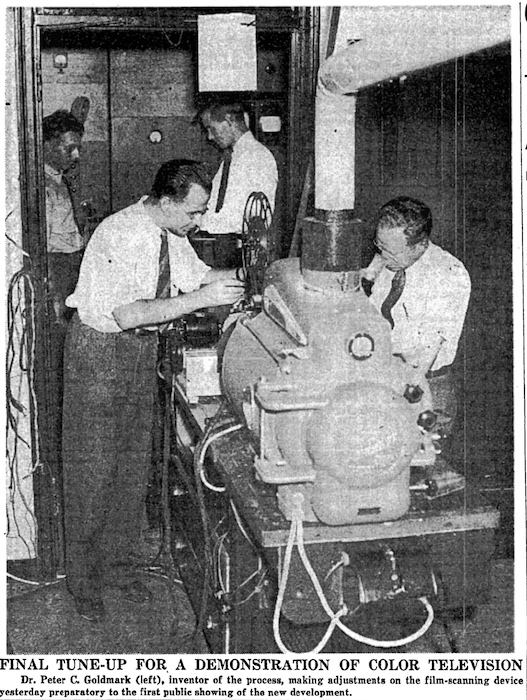
source: “COLOR TELEVISION ACHIEVES REALISM”, The New York Times, September 5, 1940, p.18.
この FSC 方式は、US 2,304,081A「Color television」として特許登録されています。
The FSC system was patented as US 2,304,081A “Color television”.
このFSC方式によるCBSカラーテレビシステムは、1950年10月1日に、連邦通信委員会 (Federal Communications Commission, FCC) によって米国のカラーテレビ規格として採用されたのですが、従来の白黒放送との非互換性のため、すったもんだの結果、1953年に RCA/NBC 等が開発したカラーテレビ規格が改めて採用されました。
The Field-Sequential Color (FSC) Television System, once adopted by FCC (Federal Communications Commission) on October 11, 1950, as the standard for color television in the U.S.. However, due to the incompatibility with NTSC, the FSC color broadcasts suspended on late 1951; RCA/NBC developed NTSC-compatible color system, which superseded the FSC system as the U.S. standard in December 1953.
今回はテレビジョンの歴史のブログ記事ではありませんので(笑)これ以上深入りするのはやめておきますが、こちらも相当ドロドロとしたストーリーがあるようです。
Ah, this blog article is not for tracing the history of television systems, so I won’t get deeply into it.
ひとつだけ興味深い余談を。結局 RCA/NBC 方式が NTSC として全米標準のカラー放送システムとなりましたが、CBS の FSC 方式カメラは、のちに1969〜1972年の NASA アポロ計画 の宇宙空間や月面からのカラー映像撮影に使われたそうです。
One interesting degression here: RCA/NBC system became the NTSC, thus the standard color television system in the U.S.. But CBS’s Field-Sequential Color system later adopted by NASA, in the Apollo Project missions during 1969 and 1972, delivering color moving pictures from the space and from the lunar surface.
Westinghouse engineers had already decided in 1968 that NASA would need a color TV camera for space missions, and had begun work to build one. An NTSC color TV camera was clearly impractical; as such devices were big and far too unreliable in harsh environments. However, a color-wheel camera, first developed by CBS in 1940, was not much more complicated than a black and white camera, and could be easily built a small hand-held unit.
Westinghouse のエンジニアは、1968年の時点で既に NASA の宇宙ミッションにカラーテレビカメラが必要であると判断し、開発に着手していた。しかし、NTSC方式のカラーテレビカメラは、大型かつ(宇宙空間のような)過酷な環境では信頼性に欠けるため、NTSC方式の採用は現実的でないことは明らかだった。一方、もともと1940年にCBSによって開発されたカラーホイールカメラでは、白黒カメラに比べても複雑性はそれほど増さず、小型のハンドヘルドユニットとして容易に製造可能だった。
The main problem was that the color-wheel camera, with its sequential red-green-blue images, was not compatible with the NTSC system, which broadcast all three colors at once. Westinghouse engineers got around the obstacle by recommending that a conversion device be installed in the Houston Mission Control Center that would store the camera’s sequential images on magnetic media, and then convert these into a standard NTSC color broadcast signal.
主な問題は、赤-緑-青のシーケンシャル表示である(FSC方式の)カラーホイールカメラは、3色を同時に放送するNTSC方式と非互換であることであった。そこで Westinghouse エンジニアが提案したのは、ヒューストンのミッションコントロールセンターに、FSCカメラの連続画像をいったん磁気メディアに記録し、それをNTSC方式のカラー放送信号に変換する装置を設置する、という方法であった。これにより問題が解決された。
“Apollo Television”, Bill Wood (former Apollo MSFN station engineer), 2005, on NASA History website11.2.7: 1945, Goldmark listens to 78rpm albums of Brahms’ Second Piano Concerto at his friend’s house
カラーテレビ開発に忙殺されていた Goldmark 氏は、アマチュアのチェロ奏者でもあり、音楽を好んでいましたが、(当時の)レコードを積極的に聴くことはなかったようです。Goldmark 氏は自伝で、次のように語っています。
Mr. Goldmark, who had been extremely busy developing color television system, was also an amateur cellist, and was fond of music, although he didn’t have any interests on listening to music with phonographs and 78rpm records. Mr. Goldmarks recalls his early days and his “zero response” to phonograph:
My initial interest in the LP arose out of my sincere hatred of the phonograph. All my life I had what we engineers call zero response to the phonograph, because it seemed to violate what I thought the quality of music should be.
私が最初にLPへの興味を持ったのは、蓄音機(と当時の78回転シェラック盤)に対する心からの憎しみからであった。私はずっと、蓄音機に対して全く興味がなかった。我々エンジニア的に言うならば、蓄音機やシェラック盤に対して「ゼロ・レスポンス」であった。というのも、(蓄音機から再生される音は)音楽とはこうあるべき、と私が考えるクオリティに反していたからだ。
“Chapter 8: The LP Caper, or the Case of the Missing Fuzz”, “Maverick Inventor: My Turbulent Years at CBS”, Peter C. Goldmark with Lee Edison, Saturday Review Press, 1973, p.127ところが、Goldmark 氏の弁によれば、1945年9月上旬(VJ Day = 対日戦勝記念日の直後)、コネチカット州の友人夫婦宅を訪問し、そこでブラームスのピアノ協奏曲第2番(指揮:トスカニーニ、ピアノ演奏:ホロヴィッツ)の78回転アルバムをオートチェンジャーで聴いたことが、全ての始まりだったそうです。
However, his ambition all started “on one evening in the fall of 1945 shortly after VJ Day”, he was visiting his friends’ house in Connecticut, where his friends played “a new recording of Brahms’s Second Piano Concerto, rendered by Vladimir Horowitz, with Arturo Toscanini conducting” – 78 rpm albums of six discs, played by a autochanger phonograph:
In the midst of listening to the first movement of this record, a terrible thing happened. There was a click, silence, and strange noises, and then the movement continued. This happened again and again. I counted twelve sides for the four movements and evleven interruptions, of which eight were unplanned by Brahms. So eight abominable times during the rendition I was in turn enthralled and jarred, like having the phone ring at intervals while you are making love. Gritting my teeth, I asked my friends to play the concerto through a second time, only to relive the horror. There was no doubt in my mind that the phonograph though in far better technical shape than the one in the Army was still murdering Horowitz, Toscanini, and above all Brahms, and I felt somehow impelled to stop this killer in its shellac tracks.
このレコードの第1楽章を聴いている最中、とんでもないことが起こった。カチッという音がして、沈黙が訪れ、奇妙なノイズが鳴ったかと思うと、楽章の続きが流れ出した。これが何度も何度も起こったのだ。4楽章で(12インチ78回転盤)12面分、合計11回の中断が起こったが、そのうち8回の中断は、ブラームスが想定していなかったものであった。つまり、演奏中に8回も、忌わしい中断が起こったのだ。まるで、愛し合っている最中に電話で中断されるようなもので、音楽に魅了されている最中に何度もギクリとさせられたのだ。私は歯を食いしばって、友人にもう1度通しでレコードをかけてもらったが、恐怖を追体験するだけだった。この時の蓄音機は、陸軍で使っていた蓄音機より技術的にはるかに優れていたにもかかわらず、ホロヴィッツ、トスカニーニ、そしてなによりブラームスを殺していることに疑いの余地はなかった。私は、このシェラック盤の溝に潜む殺人者をなんとしても止めなければならない、という気持ちに駆られたのだ。
“Chapter 8: The LP Caper, or the Case of the Missing Fuzz”, “Maverick Inventor: My Turbulent Years at CBS”, Peter C. Goldmark with Lee Edison, Saturday Review Press, 1973, p.127ともあれ、Columbia 社長の Wallerstein 氏が1939年から地道に進めていた長時間レコード開発とは別文脈で、CBS の Goldmark 氏も、高品質長時間レコード開発を行いたいと考え始めたようです(彼の自伝が真実を語っているならば)。そして自伝によると、長時間レコードに必要なさまざまな物理的特性や技術的制約を熟考し、レコードカッティングや再生に関する学術論文を一通り調査したのち、知人である Columbia のチーフエンジニア Jim Hunter 氏に頼み、コネチカット州ブリッジポートにある Columbia プレス工場を見学、初めてレコード製造現場を目にしたとのことです。
Anyway, Mr. Goldmark of CBS (if his autobiography tells the truth), too, started considering a development of longer playing records with higher fidelity, with a different context from the project of Mr. Wallerstein of Columbia Records. And according to the autobiography, he started considering various physical aspects and limitations; he found a few major technical papers by scientists at Harvard and Bell Labs; then he asked Jim Hunter (his friend who was a chief engineer at Columbia Records) to take him through the company’s record plant in Bridgeport, Conneticut, and Mr. Goldmark enjoyed the fantastic sight for the first time.
プレス工場見学のあと、Jim Hunter 氏は、Goldmark 氏を Columbia 社長である Edward Wallerstein 氏に紹介します。その時のことを、Goldmark 氏は自伝で次のように描写しています(真実かどうかはさておき)。
After the tour of the factory, Mr. Hunter took Mr. Goldmark to see the (Hunter’s) boss at CBS, Edward Wallerstein. His autobiography renders this initial contact with Mr. Wallerstein (I have no idea if his autobiography tells the truth or not, anyway):
After my tour of the Columbia factory Jim took me to see his boss Edward (Ted) Wallerstein, an assertive fellow, full of self-importance, who run Columbia Records. Wallerstein had been hired out of RCA by Paley because it was reputed that he was the best phonograph salesman of his day.
Columbia の製造工場を見学したのち、Jim は私を連れて、彼の上司である Edward (Ted) Wallerstein に会わせた。Ted は自己主張が強く、威厳に満ちた人物であり、当時 Columbia Records の経営にあたっていた。彼は当時最高の蓄音機セールスマンという評判があり、CBS の Paley 氏から雇われて Columbia 社長になったのだ。
He listened to me patiently for exactly three minutes, put an arm around my shoulders, and suggested in a fatherly manner that I should drop the entire project and do something in the television line instead. RCA, he pointed out, had toyed with the 33 1/3 record for the consumer and had gotten nowhere. That was his final word to me on the matter.
彼は私の話を3分ほど辛抱強く聞いたのち、私の方に腕を回し、まるで父親のように私にこう提案した。「そのプロジェクトとやらはやめにして、代わりにテレビジョンの分野で何かやってはどうかな」。RCA はかつて、市販用に 33 1/3回転のレコードを開発したが、結局どうにもならなかった、と彼は指摘した。それが、この件(長時間レコード開発)に関する彼の最後の言葉だった。
Such a patronizing attitude drove me harder to ferret out a way to accomplish what Wallerstein and RCA believed was impossible.
このような見下した態度をとられたことにより、私はますます、Wallerstein や RCA が不可能だと信じていることをなにがなんでも実現したい、その方法を探りたい、と駆り立てられたのだ。
“Chapter 8: The LP Caper, or the Case of the Missing Fuzz”, “Maverick Inventor: My Turbulent Years at CBS”, Peter C. Goldmark with Lee Edison, Saturday Review Press, 1973, p.127かたや、第二次世界大戦開始前から長時間レコードの開発を念頭に置いていたColumbia の社長。かたや、CBS のカラーテレビ研究開発者で、長時間レコード開発プロジェクトに首を突っ込んできた者。共に個性が強く、いろいろ衝突があったことは間違いないでしょう。
One is the president of the Columbia Records, who had believed the possibility of longer playing records even before the WWII; the other is an engineer and a Ph.D researcher of CBS, developing a color television system, who somehow started to wish to develop longer playing records too. As both having strong personalities, there would be some dissension and “bad moods” between the two.
このことが、Wallerstein氏のインタビュー、Goldmark氏の自伝、それぞれを客観的に読むことが出来ない(真実が書かれているのはどこか、どこが脚色か、の判断が困難である)、最大の背景でしょう。
And this would be the big reason that we cannot easily understand the history of the LP development from “objective” viewpoint – we cannot easily judge which part tells the truth in their autobiography and interviews.
11.2.8: 1945-1948, CBS/Columbia’s collaborative LP development
ともあれ、1945年には、CBS と Columbia 双方のエンジニアからなるチームによる、長時間レコード開発プロジェクトが本格的に発足します。Goldmark 氏の説得を辛抱強く聞き、プロジェクトに最終的にGOを出し、予算確保を確約してくれたのは、CBS 副社長 Paul Keston 氏でした。
Anyway, in late 1945, the LP development project started by a CBS=Columbia joint team, in earnest. It was Paul Keston, vice president at CBS, who patiently listened patiently to Mr. Goldmark’s enthusiastic (but frustrated) scientist, and approved to invest over a hundred thousand.
そして、Goldmark 氏は、1944年から CBS に所属する録音エンジニア René Snepvangers をプロジェクトに呼び寄せます(以下に引用した、New York Times 誌の訃報では「Snepvangers 氏は1944年にCBSに合流、長時間レコード部門の部長となった」と書かれているので、Goldmark 氏の自伝とはまたまた異なる記述となっています)。Snepvangers 氏も、もともと1939年から RCA に勤務、NBC 向けのトランスクリプション盤のエンジニアとしてその手腕が高く評価されていました。
And Mr. Goldmark hired René Snepvangers to the project (again, discrepancy here – Mr. Goldmark’s autobiography reads that he hired Snepvangers from RCA/NBC, while on the other hand, the following article of René’s obituary reads that “In 1944 Mr. Snepvangers joined the Columbia Broadcasting System and became head of its long-plaing record division”). Mr. Snepvangers was an RCA engineer since 1939, working for NBC transcriptions, his work being highly praised.
彼の訃報を伝える New York Times の記事では「録音分野における彼の仕事は、あのアルトゥーロ・トスカニーニにも賞賛された」と書かれています。
The New York Times’ article of René’s obituary praises his work: “His work in the field of recording was praised by Arturo Toscanini”.
ここから、1948年のLP発表直前まで、研究開発が日々行われました。
Since the start of the CBS=Columbia joint project of LP development, until the advent of LP records in 1948, research and development was conducted as a daily basis.
当初は12インチ33 1/3回転の片面で7〜8分、そして片面12分、さらに片面17分、と記録密度が上がり続けても、その都度 Wallerstein 氏が「それでは長時間レコードとは言えない」とダメ出しを続けたり。
Initially the newly developed media held seven to eight minutes per side on a 12-inch 33 1/3rpm record; then twelve minutes of music per side; and seventeen minutes of music per side. However, Mr. Wallerstein kept saying “that’s not a long-playing record”.
せっかくのヴィニライト製なのにノイズが多く、原因を探るとプレス工場の床掃除をしすぎたせいで埃が舞いあがり、それがプレス時に混入していたことが判明したり。
Newly developed discs mysteriously had noisy surfaces, although made of Vinylite – “which turned out to be caused by over-zealous sweeping of the floor in the factory, raising dust that was then pressed into the plastic grooves” (according to Donald’s Encyclopedia of Popular Music).
Bachman 氏の開発による “Hot Stylus” カッターヘッドにより記録特性が圧倒的に向上したのに、歪が多く、全録音機器を分解して調査、最終的にはドイツから最新のマイクを入手して位相歪に対応、スタジオ内でピストルを撃ち、その音をカッティングすることで確認したり。
Although Mr. Bachman’s development of “Hot Stylus” cutterhead enabled far better frequency range and better fidelity being cut on lacquer discs, it still produced fuzz. The team disassembled all the components that went into microphone, and concluded they needed a new German-made condenser microphone. They checked the fuzz by firing pistol shots and recording that sound.
78回転時代の既存録音(の16インチ 33 1/3回転セーフティマスター)からLPカッティングする際のシステム構築の苦労だったり。
They had struggled (and finally perfected) developing a precise cueing system that transfers (16-inch 33 1/3 rpm safeties of) old recordings to a 12-inch 33 1/3 rpm lacquer master.
はやく RCA をギャフンと言わせたい Paley 氏が発表を急かす中、Wallerstein 氏が「まだまだ完成には遠い」と開発チームを叱咤、それに技術的に対処するエンジニア達だったり。
Mr. Wallerstein repeatedly threw cold water on Mr. Paley’s enthusiasm, who wanted to have something that Sarnoff and RCA didn’t, by saying “Sorry, that’s still not a long-playing record”. And the engineering team managed to solvet every issue technically.
…これらのいきさつについては、歴史物語として非常に魅力的で、各登場人物の言い分をパズルのように当てはめながら推理小説の様に想像する楽しさがあります。しかしさすがに、当ブログ記事で全てを紹介するには長すぎます(笑)。
…These stories are, as a series of historical tale, simply amazing and fascinating – like reading a detective novels, by matching every piece of all characters tells, and making a conjecture. However, the story is too long (and complicated) to include this personal blog article.
そこでぜひ、最低でも (1) Wallerstein 氏へのインタビュー「Creating the LP Record」(High Fidelity Magazine, April 1976, pp.56-61)、(2) Goldmark 氏の自伝「Maverick Inventor: My Turbulent Years At CBS」 (Saturday Review Press, 1973)、および、(3) 極力客観的に綴られた「THE LABEL: The Story of Columbia Records」 (Thunder’s Mouth Press, 2007) を、読んでみてください。
So, I would like to strongly recommend you to read at least the followings: (1) Interview with Mr. Wallerstein in 1967 “Creating the LP Record” (High Fidelity Magazine, April 1976, pp.56-61); (2) Mr. Goldmark’s autobiography “Maverick Inventor: My Turbulent Years At CBS” (Saturday Review Press, 1973); and (3) (from more objective viewpoint) “THE LABEL: The Story of Columbia Records” (Thunder’s Mouth Press, 2007).
1977年10月28日、ニューヨークで行われた William Bachman 氏へのインタビューでは、Goldmark 氏がどの程度開発に関与していたか、彼の口から語られる箇所があります。
William Bachman tells in the interview on October 28, 1977, New York (by James A. Drake) that to what extent Dr. Goldmark contributed in the top-secret LP development.
How did you and Dr. [Peter] Goldmark divide your work on the Columbia LP project?
Columbia LP プロジェクトにおいて、あなたと Goldmark 氏の間で、どのように作業を分担されていたのですか?
Well, we didn’t, really. Peter was so involved in television [development] that he essentially turned over the LP to me. He was senior to me, of course, so it was his project and I was his collaborator, but he asked me to run the LP development on a day-to-day basis.
そうですね、実は、分担などはしていなかったのです。Peter はテレビの開発にかかりっきりでしたから、LP開発プロジェクトは実質的に私が引き継いだようなものです。もちろん、彼の方が先輩ですから、LP開発は彼のプロジェクトであり、そして私は彼の協力者という立場ではありました。ですが、私が日々のLP開発を遂行するように、と彼は依頼してきたのです。
To what extent was Mr. [William S.] Paley involved in the LP project?
(CBS会長の) Paley 氏は、LP開発プロジェクトにどの程度関与していましたか?
Not at all until it came time to introduce it publicly. Mr. Paley was never that interested in the Columbia Records division. Visionary that he was, he knew that whichever company came up with the best color television system would dominate that industry. He knew that RCA was working on a color system, and nothing gave Bill Paley more gratification than beating General [David] Sarnoff to the market with the best possible system.
公に発表する時期が来るまでは、彼の関与はまったくありませんでした。Paley 氏は、Columbia Records 部門にはそれほど興味を持っていませんでした。彼には確かに先見の明がありましたから、カラーテレビシステムを開発した会社が業界を制覇する、と知っていました。そして RCA 社もカラーテレビシステムを開発中であると知っていましたし、Paley 氏にとって、最高のシステムで(RCA の)Sarnoff 社長を打ち負かすことこそが最高の喜びだったはずです。
“The James A. Drake Interviews: William S. Bachman on the Development of the Columbia LP”根っからのエンジニアである Bachman 氏の言説を信用するならば、LP開発の真の貢献者をひとりあげるとすれば、やはり Bachman 氏ということになるでしょうか。
If we believe these statements by Mr. Bachman, who was fundamentally an engineer, we would say that one of the most important contributors for the LP development would definitely be Mr. Bachman himself.
11.2.9: Who Contributed in Which Aspect Anyway
ともあれ、極秘裏に進められた Columbia LP 開発プロジェクトにおける、主たる登場人物は、以下のようになるでしょう。
Anyway, the main contributors for the top-secret development project of Columbia LP records would be as follows:
- William (Bill) Paley
- CBS創業者、のちに社長、そして会長。RCA社長 David Sarnoff に並々ならぬライバル心を燃やし、RCA と RCA Victor に勝つ製品や技術を渇望。のちに Goldmark 氏と CBS ラボに「LP開発」の称号を与える(訃報を伝える New York Times 誌の記事)
- Founder of CBS, then president, and chairman, who had strong (and personal) rivalry with RCA president David Sarnoff, wishing any products and technologies that beat RCA and RCA Victor. He later gave all the credit to Mr. Goldmark and the CBS Labs (Obituary article on New York Times)
- Edward (Ted) Wallerstein
- RCA Victor GM 時代から、長時間レコード開発を望んでいた Columbia Records 社長。途中から関わってきた Goldmark 氏とはあまりいい関係ではなかった(訃報を伝える New York Times 誌の記事)
- President of Columbia Records, who had wished long-playing record since he was a GM at RCA Victor. He and Mr. Goldmark probably didn’t have a good mood (Obituary article on New York Times)
- Peter Goldmark
- CBS でカラーテレビ開発を行い特許を取得(US2,304,081A)した研究者、自称「異端の発明家」。戦後 LP 開発に首を突っ込み始め(笑)、LP 開発プロジェクトのリーダを務める。のちに「LPの発明者」の称号を得る。ただし、実際にはあまり技術的貢献はしてなかったという説もある(訃報を伝える New York Times 誌の記事)
- A researcher who engaged in Color TV development at CBS, and filed the patent (US2,304,081A), calling himself a “Maverick Inventor”. After the WWII in 1945, he also get involved in the LP development, becoming a leader of the project. Later he obtained the title of “the inventor of the LP”. However, some people claimed he merely was more or less a supervisor, and he was so busy developing color TV system (Obituary article on New York Times)
- William (Bill) Bachman
- GE でバリレラを開発、特許を取得(US2,511,663A)後、1946年に Columbia に移籍。カッターヘッドを電熱線で温めながらカッティングする技術や、のちに可変ピッチによるカッティングなど、マイクログルーヴLP誕生に欠かせない重要な技術開発を担当(1977年のインタビュー)
- A young and talented engineer who developed “Variable Reluctance” pickup while he was in General Electric (his patent: US2,511,663A). Later in 1946 he joined the Columbia, and became an important member of the LP development project. He also developed “Heated Stylus” recording technique, as well as “Variable-pitch” cutting system (His interview in 1977)
- René Snepvangers
- RCA/NBC でトランスクリプション盤の録音エンジニアとして従事後、CBS に移籍。LP再生に欠かせない軽量ピックアップの改良に従事 (訃報を伝える New York Times 誌の記事)
- A recording engineer at RCA/NBC for transcription records; joined CBS in 1944, and contributed developing/improving light-weight pickups that was crucial to microgroove LP playback (Obituary article on New York Times)
- James (Jim) Hunter
- RCA Victor で最初期のヴァイナル化合物開発を担当、Columbia に移籍後も LP 盤の原材料となるヴィニライト開発に従事
- An engineer who developed early vinylite “Victrolac” while at RCA Victor; after he joined Columbia, he perfected the development of vinylite compound for LP records
- Ike Rodman
- Musak トランスクリプション盤の録音に従事したのち Columbia に移籍した録音エンジニア。16インチセーフティマスターからLPマスターへのトランスファーを行う録音再生システムを開発、特許 (US2,426,241) を取得
- A recording engineer who worked at Musak Transcriptions, later joined Columbia; he developed a recording/reproducing system that transfers 16-inch safeties to LP master lacquers (his patent: US2,426,241)
- Bill Savory
- Benny Goodman の Carnegie Hall コンサート録音を担当したことで有名な Columbia の録音エンジニア。16インチセーフティマスターからLPマスターへのトランスファー時のカッティングを担当 (国立ジャズ博物館が全 Savory Collection を収蔵したことを伝える記事)
- A famous Columbia recording engineer, best known for his work of Benny Goodman’s Carnegie Hall concert. He was in charge of cutting the LP master lacquers from 16-inch safeties (an article that reports the National Jazz Museum in Harlem acquires the entire set of the Savory Collection)
- Howard Scott
- ニューヨーク響やグールドのアルバムプロデュースで有名な、Columbia Masterworks 担当プロデューサ。最初期のLPリリース時、16インチセーフティマスターからLPへのトランスファー時のディレクターを担当(訃報を伝える Sydney Morning Herald 誌の記事)
- A producer for Columbia Masterworks (Classical) sessions, famous for his works with New York Philharmonic, Glenn Gould, etc. He was a director of transfering 16-inch safeties to LP master lacquers (Obituary article on Sydney Morning Herald)
- Vincent (Vin) Liebler
- Robert Johnson の Vocalion 録音担当で著名な、Columbia の録音エンジニア (彼の功績を讃えるブログ記事)
- A famous recording engineer at Columbia, best known as Robert Johnson’s Vocalion field sessions (an article praising his work)
11.2.10: Why Mr. Paley Gave All The Credit to Mr. Goldmark and the CBS Labs
LP開発は、Columbia のエンジニアと CBS のエンジニアで構成されたチームによる共同作業でしたが、結局、プレス向け公開の時には、Peter Goldmark 氏と CBS ラボの貢献が強調される結果となりました。これは、CBS 会長の William Paley 氏の意向と言われています。
As a matter of fact, the LP development was conducted by a joint project of CBS engineers and Columbia engineers. But after all, when unvailed, the emphasis was laid on Dr. Peter Goldmark as well as CBS Labs. It has been said that the CBS chairman William Paley wanted to do so.
LP開発プロジェクトに従事したエンジニアの多くが、RCA / Victor から CBS / Columbia に移籍してきた人々だったため、RCA(の Sarnoff 社長)を過度に刺激しないように配慮した、という事情もあるのかもしれません。
It could be because many of the project members were originally working at RCA / Victor, then they were hired to CBS / Columbia, Mr. Paley did not want to be disturbingly provocative against RCA’s president David Sarnoff.
はたまた、当時全米標準の次世代カラーテレビ規格にすべく開発していた FSC 方式の主たる開発者である Goldmark 氏への配慮だったのかもしれません。
Or it could be Mr. Paley’s some sort of consideration to Dr. Peter Goldmark, who had been developing the FSC Television System that would be the next-gen national standards (but failed in vain).
はたまた、あくまで Columbia は CBS の傘下である、ということを強調したかったのかもしれませんし、RCA の Sarnoff 社長に向けての宣戦布告のメッセージとして CBS という看板を前に出したかったのかもしれません。
Or it could be that Mr. Paley wanted to stress the fact, that Columbia Records Inc. was a wholly-owned CBS subsidiary: or a straightahead message from CBS to RCA (and its president David Sarnoff).
真実は闇の中ですが、ともあれ、LP開発プロジェクトに関わった幾多のエンジニア達の尽力によって、1948年6月18日にお披露目され、その後数十年間に渡り世界中の主要メディアの位置を確立したのです。
The truth is a mystery – anyway, with extraordinary contributions by many talented engineers in the LP development project, the Long Playing Microgroove records made brilliant debut on June 18, 1948, and had acquired highly regarded status as a primary sound medium for dozens of years to come.
11.2.11: “Battle of the Speeds” Could Have Been Avoided?
実は、1948年6月のLPお披露目前に、CBS/Columbia は RCA/Victor に密かに新開発の長時間レコードをお披露目していたのです。それは、1948年4月、CBSの役員室におけるデモンストレーション、および会合でした。
Another interesting side-story: before June 1948 of press demonstration, CBS/Columbia held a demonstration / meeting behind closed doors with RCA/Victor president and his engineers. It was in April 1948.
So came the fateful day in April 1948. CBS president Frank Stanton greeted David Sarnoff and his RCA engineers as they arrived at the CBS boardroom. Then, with Paley and the Columbia Records team observing, Stanton used two different turntables to demonstrate the long-playing record versus the old 78 disk.
こうして1948年4月、運命の日がやってきた。CBS社長の Frank Stanton 氏は、CBS の役員室に到着した (RCA社長) David Sarnoff 氏と RCA エンジニア一行を出迎えた。そして、(CBS会長) Paley 氏や Columbia Records の面々が見守る中、Stanton 氏は2台のターンテーブルを使い、新開発の長時間レコードと旧来の78回転レコードのデモを行った。
The actual audio material played that day has been lost to memory, but the effect, according to Goldmark, “was electrifying, as we knew it would be. I never saw eight engineers look so much like carbon copies of tight-lipped gloom.”
この日、役員室で実際に流された音は、もう記憶の彼方となってしまったが、その効果は、Goldmark 氏によると「予想通りではあったが、衝撃的なものだった。8人の(RCAの)エンジニアが、揃いも揃ってカーボンコピーのように、口を閉ざし憂鬱な表情を浮かべる姿は、初めて目にした。」
“Chapter 9: Creation of the LP”, “The Label: The Story of Columbia Records”, Gary Marmorstein, Thunder's Mouth Press, 2007, p.164当時の2大レーベルにしてライバル同士の RCA Victor と Columbia であっても、相手がどのような開発を行なっているかは分からなかった。それだけプロジェクトは極秘裏に進められていたことがわかります。
Even RCA Victor and Columbia – two major labels with rivalry – didn’t know what kind of development the rival was doing. This proves that the CBS/Columbia’s LP development project had been kept such strictly secret, behind closed doors.
Stanton remembered how upset Sarnoff was. “I can’t believe little Columbia Graphophone invented this without my knowing it,” Sarnoff whined, trying to belittle the achievement by employing the company’s nineteenth-century name.
Stanton 氏は、Sarnoff 氏がどれほど動揺していたか覚えていた。「あの小さなコロムビア・グラフォフォン社が、自分の知らないうちにこんなものを発明していたとは。。。」 このように Columbia の19世紀の社名を口に出し、この新開発の功績を軽んじるかのように、Sarnoff 氏は愚痴っていたそうだ。
Wallerstein’s memory was that Sarnoff looked down his side of the table at his RCA engineers, pulled the cigar from his mouth and said, “You sonsabitches got caught with your pants down again!”
Wallerstein 氏の記憶によると、Sarnoff 氏は横にいる RCA のエンジニア達を見下ろし、くわえていた葉巻を手に持ち、こう言ったそうだ。「このくそったれどもめ、またしても不意打ちくらってるじゃねえかよ!」
“Chapter 9: Creation of the LP”, “The Label: The Story of Columbia Records”, Gary Marmorstein, Thunder's Mouth Press, 2007, p.164この箇所、当時の Columbia 社長の Frank Stanton 氏の回想は、1994年2月17日に行われたインタビューが一次資料ということのようです。とても長いですが、読み応え抜群でおすすめのインタビューです。1939年〜1948年あたりの話は Page 618 およびそれ以降で語られています。
Frank Stanton’s above remembering is quoted from the interview with him on February 17, 1994. It’s very interesting and worth reading through – highly recommended. The story around 1939-1948 is told on Page 618 and beyond.
そして、CBS / Columbia 側は、RCA / Victor 側に技術ライセンス供与の提案を持ちかけます。
After the demonstration, CBS/Columbia offered a license arrangement with RCA / Victor.
When the atmosphere calmed, Paley offered to discuss a licensing arrangement with Sarnoff. This was really what Paley had been going for all along – to cash in on the long-playing technology by making other companies, RCA in particular, pay for it. (Wallerstein claimed that it was Goldmark who planted the idea in the boss’s head.) Sarnoff graciously congratulated Paley and said he would consider his offer to share the technology.
場の雰囲気が落ち着いたところで、Paley 氏は Sarnoff 氏にライセンス契約の話をもちかけた。これは Paley 氏がずっと狙っていたことで、他社、特に RCA 社にお金を出させ、LP の技術から利益を得ようというものであった(Wallerstein 氏によると、このアイデアをボスの Paley 氏に植え付けたのは Goldmark 氏とのことである)。Sarnoff 氏は、Paley 氏を快く祝福し、技術供与の申し出を検討させてもらいたい、と言った。
But there was no reason to do so because there was nothing patentable; the long-playing record had been developed using only tools at hand.
しかし、Paley 氏(RCA/Victor)が技術供与を受ける理由はどこにもなかった。なぜなら、この長時間レコードは、手持ちの機材だけで開発されたものであり、どこにも特許になるような側面がなかったからである。
“Chapter 9: Creation of the LP”, “The Label: The Story of Columbia Records”, Gary Marmorstein, Thunder's Mouth Press, 2007, p.164結局、RCA/Victor は CBS/Columbia の提案を受けることなく、6月のプレスデモンストレーション後も沈黙を保ちます。そして1949年初頭、RCA Victor は沈黙を破り、やはり極秘開発していたコードネーム「Madame X」すなわち7インチ45回転マイクログルーヴ盤を発表します。ここから、以前当サイトで EP の語源を調査した記事 でも触れた通り、1年半に渡る「Columbia 対 RCA Victor スピード戦争」が始まります。
After all, RCA/Victor did not accept CBS/Columbia’s offer: the company kept silence after the June 1948’s LP press demonstration. And in early 1949, RCA Victor suddenly broke the silence, and proudly unleashed the 7-inch 45 rpm microgroove records, code-named “Madame X”. From this moment on, as I wrote in my old article on the origin of the term “EP”, the famous “Battle of the Speed” broke out – and it lasted one and a half year.
11.3 The summary of what I got this time / 自分なりのまとめ
今回は自分史上最長の記事となってしまいましたが、分割せずに一挙に掲載することとしました。
This Pt.11 may be the longest article I have ever written on my weblog… but anyway here it is.
前回の Pt.10 も長かったですが、今回はそれ以上に長くなってしまいました(笑)。我々が現代でも親しんでいる「LP」誕生のストーリーが、こんなにも複雑で複層的で謎解きのようなものだったとは、びっくりしました。
The previous part 10 was lengthy enough, but this Pt.11 became a much longer piece. I didn’t know that the story of “the birth of LP records” really was complicated and multitiered, like reading detective novels.
さてさて、今回の内容をざっくりまとめると、こんな感じでしょうか。
…so, the rough summary of my understanding in this article would be something like this:
1948年6月18日、ニューヨークのウォルドルフ・アストリアホテルで、Columbia LP がプレス向けに華々しくお披露目された。この時、101枚のLPアルバムと、同内容の78回転アルバム101セットが比較展示され、収納スペース効率化が喧伝された。また、LPの再生も披露され、従来のシェラック盤に比べてスクラッチノイズが非常に少なく高品質な再生音は、参加者を驚かせた。
The press demonstration of Columbia Long Playing Microgroove Records was taken place at the Wardolf-Astoria Hotel, NYC on June 18, 1948. 101 LP albums and a pile of 101 (78-rpm) albums were graphically demonstrated to prove less storage space needed for LP albums. Also listening quality demonstration was conducted, showing far less scratch noise, with better fidelity – that amazed participants.
マイクログルーヴLP開発は、実は1930年代のRCA Victor時代に端を発していた。その後、1939年にCBS傘下となったColumbia、およびCBSに、RCA/NBCのエンジニアが続々と集結、1939年から秘密裏に開発が進められた。
The development of microgroove LP records (surprisingly) originated from the experiments in the 1930s, at RCA Victor. After Columbia became a subsidiary of CBS in 1939, RCA/NBC engineers gradually joined Columbia, and started the top-secret project, behind closed doors.
RCA Victorから移籍しColumbia社長となったWallerstein氏は、1939年1月の開発開始にあたり、将来長時間レコードが実現した時のために、すべての78回転用録音を、16インチ33 1/3回転のラッカーにも同時カッティングしておくことを命じた。これにより、1948年のLP登場以降、旧譜再発に際して他レーベルよりも比較的高音質でのリイシューが可能になった。
Mr. Wallerstein, who left RCA Victor and became the president of Columbia, made a decision to make use of 16-inch 33 1/3 rpm lacquer discs for safeties on everything being recorded for 78rpm releases, so that the recordings would be immediately transferred to microgroove when the time was right. Because of his foresight, Columbia could reissue high quality LP reissues of pre-LP recordings, enjoying a big advantage to other labels.
第二次大戦中はプロジェクトは中断していたが、CBSでカラーテレビ開発に従事していた Peter Goldmark 氏が長時間レコード開発に興味を持ち、CBS/Columbia合同プロジェクトとして戦後直後の1945年に再スタートを切った。彼はプロジェクトリーダであったが、実質的な技術開発は、名うてのエンジニアたちによって行われたと考えられる。
The project was suspended during the WWII. Peter Goldmark, who was a CBS researcher, developing a color TV system, got interested in long-playing records as well, and the project resumed in 1945, as a CBS Labs / Columbia Records joint project. Although Mr. Goldmark was a supervisor of the project, it is said that most of the practical work had been done by a number of talented engineers from Columbia and CBS.
1948年4月、LPお披露目の2ヶ月前、CBS/Columbia は極秘に RCA/Victor に LP のデモを行い、技術ライセンス供与を打診した。しかしLPを構成する技術は特許になっておらず、またRCAとCBSの宿命のライバル関係もあり、RCAはそれを断った。翌年、RCA Victor は45回転7インチレコードを独自に発表、回転数競争が勃発した。
In April 1948, two months before Columbia unvailed LP records, CBS/Columbia held a meeting behind closed doors with RCA/Victor to demonstrate the newly developed record, and offered a license agreement. However, every aspect of LP technology was not protected by patents, and because there had been a long-time rivalry between parent companies (RCA vs CBS), RCA/Victor did not accept the offer. Next year, RCA Victor unveiled 45rpm 7-inch records – then started the famous “Battle of the Speed”.
次回は、今回紹介できなかった、Columbia LP の録音再生EQカーブまわりについて学んでいきます。
My next post will feature the “Columbia LP” recording/reproducing EQ curve, and some others.
» 続き / Sequel: “Things I learned on Phono EQ curves, Pt.12” »

